ATTRACTION
The Green Wall
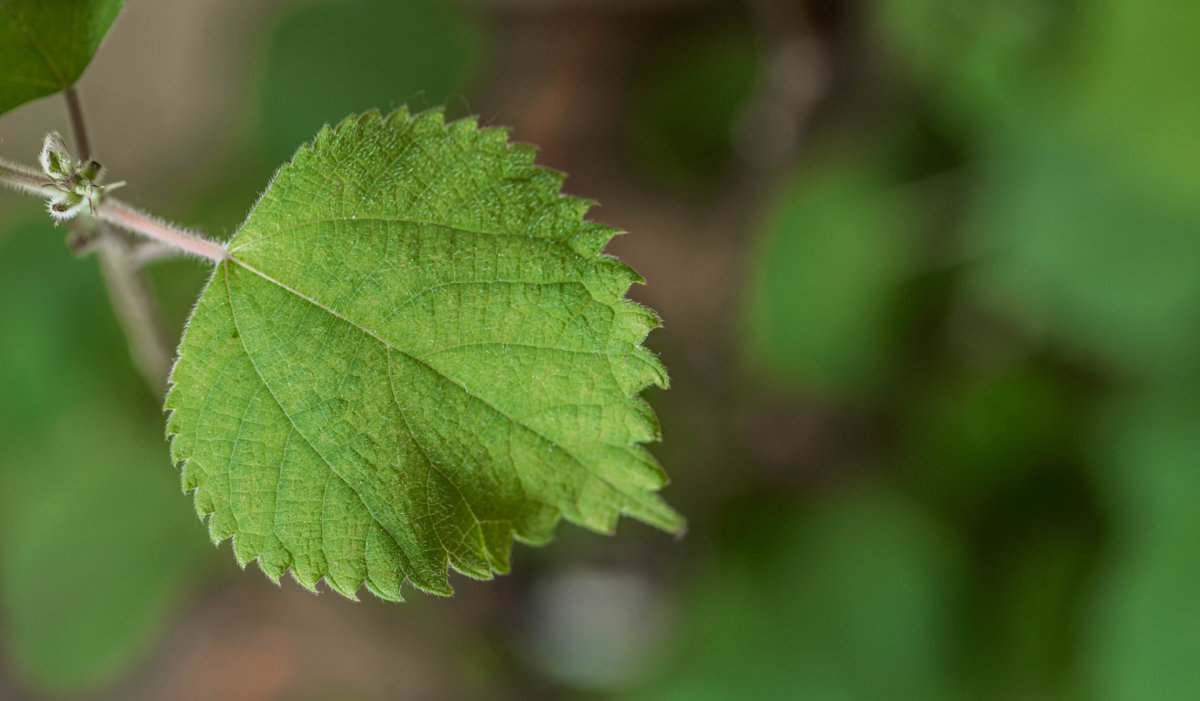


The Green Wall:
sharing the story of plants and The Mills with you
Since the beginning of the year, an elaborate and carefully constructed The Green Wall has been on display on 3/F. Composed of tree cotton, ramie plants, and 2 large pieces of hand embroidered art, the piece is aimed at highlighting the importance of plants.
Plants provide us with oxygen, materials, clothing, and an overall heightened sense of well-being. At The Mills, we have teamed up with curator Lab Pheno and botanist Forest Round Round to use cotton and linen in creating the embroidered art.
By displaying the raw materials and elaborate artwork created using cotton and linen, we hope that the The Green Wall gives visitors a better understanding and appreciation of all that plants provide us, now and throughout history.
At The Mills, we want to carry on our legacy as a former textile mill with a future of applied creativity and innovation, and continue to touch upon topics through an interesting and aesthetic way.
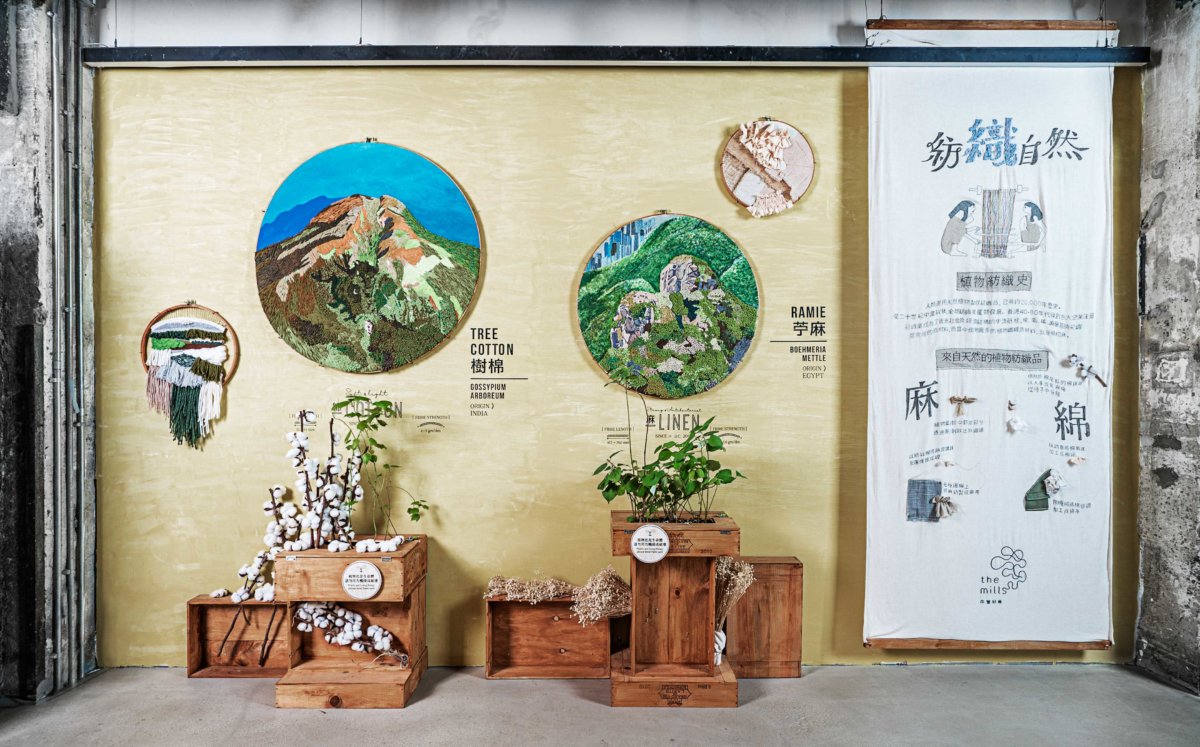


The Green Wall:
sharing the story of plants and The Mills with you
Since the beginning of the year, an elaborate and carefully constructed The Green Wall has been on display on 3/F. Composed of tree cotton, ramie plants, and 2 large pieces of hand embroidered art, the piece is aimed at highlighting the importance of plants.
Plants provide us with oxygen, materials, clothing, and an overall heightened sense of well-being. At The Mills, we have teamed up with curator Lab Pheno and botanist Forest Round Round to use cotton and linen in creating the embroidered art.
By displaying the raw materials and elaborate artwork created using cotton and linen, we hope that the The Green Wall gives visitors a better understanding and appreciation of all that plants provide us, now and throughout history.
At The Mills, we want to carry on our legacy as a former textile mill with a future of applied creativity and innovation, and continue to touch upon topics through an interesting and aesthetic way.
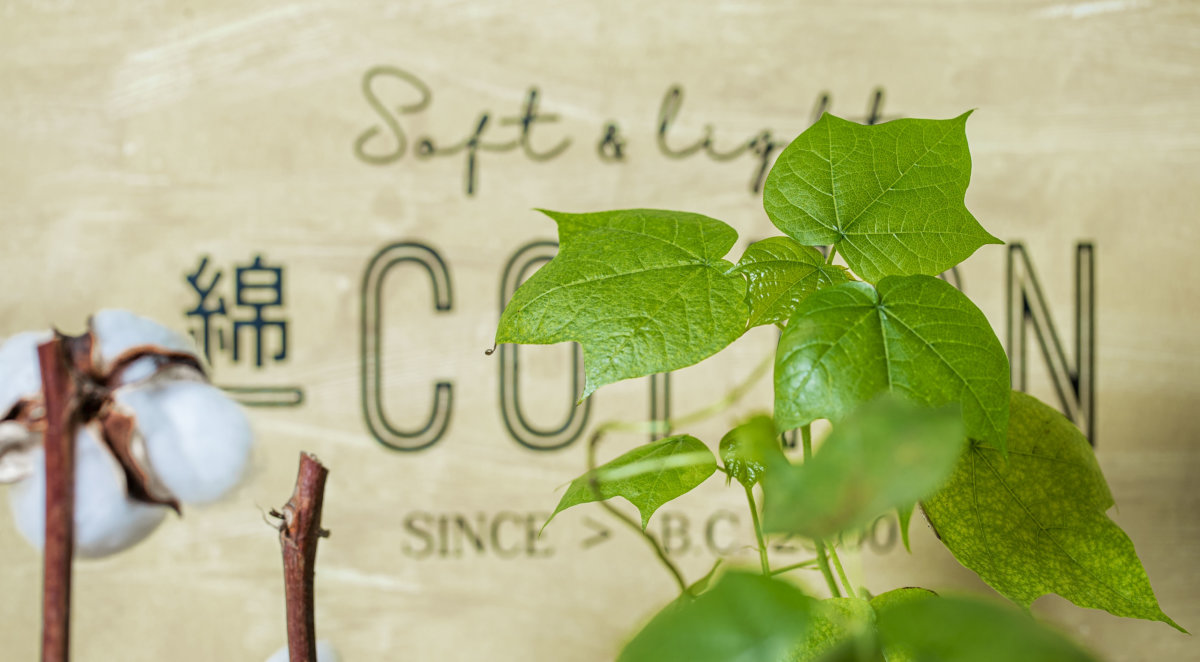


The Green Wall:
sharing the story of plants and The Mills with you
Since the beginning of the year, an elaborate and carefully constructed The Green Wall has been on display on 3/F. Composed of tree cotton, ramie plants, and 2 large pieces of hand embroidered art, the piece is aimed at highlighting the importance of plants.
Plants provide us with oxygen, materials, clothing, and an overall heightened sense of well-being. At The Mills, we have teamed up with curator Lab Pheno and botanist Forest Round Round to use cotton and linen in creating the embroidered art.
By displaying the raw materials and elaborate artwork created using cotton and linen, we hope that the The Green Wall gives visitors a better understanding and appreciation of all that plants provide us, now and throughout history.
At The Mills, we want to carry on our legacy as a former textile mill with a future of applied creativity and innovation, and continue to touch upon topics through an interesting and aesthetic way.
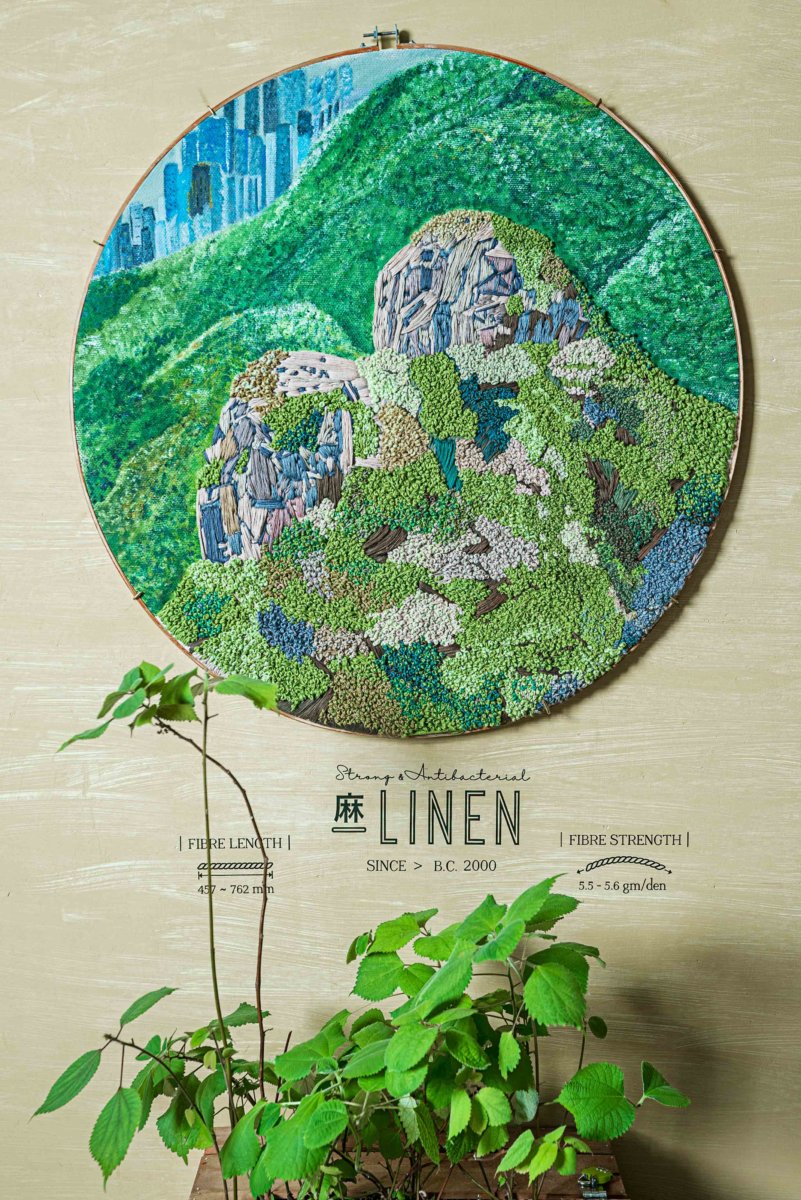


The Green Wall:
sharing the story of plants and The Mills with you
Since the beginning of the year, an elaborate and carefully constructed The Green Wall has been on display on 3/F. Composed of tree cotton, ramie plants, and 2 large pieces of hand embroidered art, the piece is aimed at highlighting the importance of plants.
Plants provide us with oxygen, materials, clothing, and an overall heightened sense of well-being. At The Mills, we have teamed up with curator Lab Pheno and botanist Forest Round Round to use cotton and linen in creating the embroidered art.
By displaying the raw materials and elaborate artwork created using cotton and linen, we hope that the The Green Wall gives visitors a better understanding and appreciation of all that plants provide us, now and throughout history.
At The Mills, we want to carry on our legacy as a former textile mill with a future of applied creativity and innovation, and continue to touch upon topics through an interesting and aesthetic way.
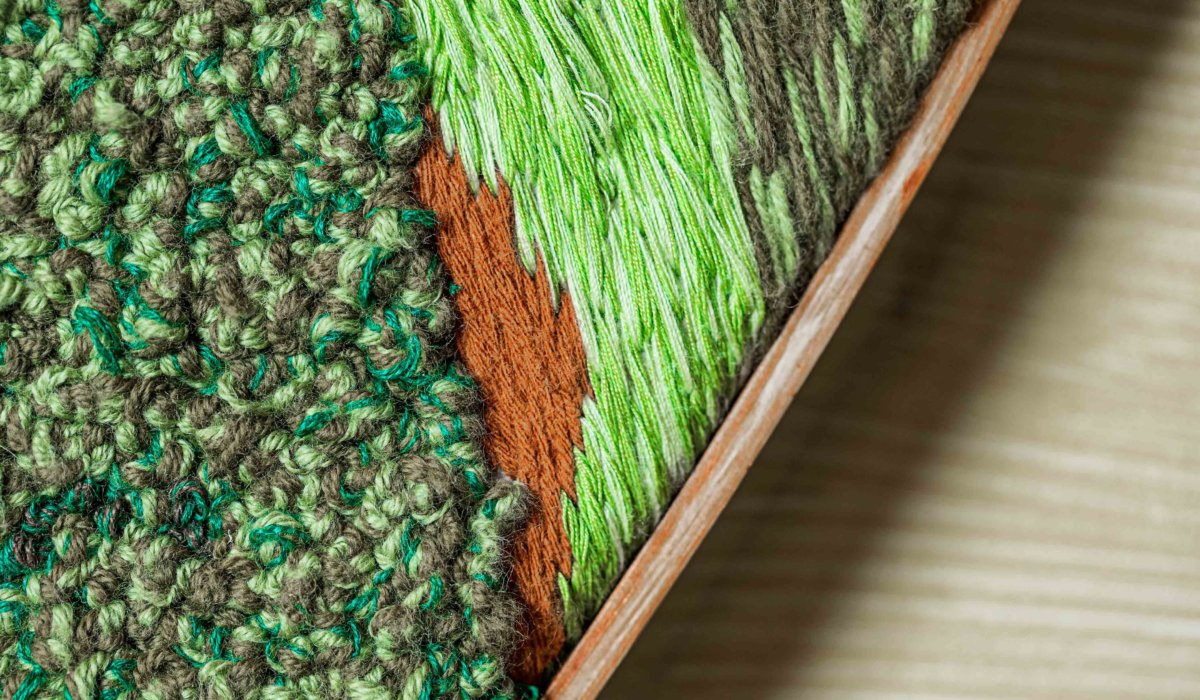


The Green Wall:
sharing the story of plants and The Mills with you
Since the beginning of the year, an elaborate and carefully constructed The Green Wall has been on display on 3/F. Composed of tree cotton, ramie plants, and 2 large pieces of hand embroidered art, the piece is aimed at highlighting the importance of plants.
Plants provide us with oxygen, materials, clothing, and an overall heightened sense of well-being. At The Mills, we have teamed up with curator Lab Pheno and botanist Forest Round Round to use cotton and linen in creating the embroidered art.
By displaying the raw materials and elaborate artwork created using cotton and linen, we hope that the The Green Wall gives visitors a better understanding and appreciation of all that plants provide us, now and throughout history.
At The Mills, we want to carry on our legacy as a former textile mill with a future of applied creativity and innovation, and continue to touch upon topics through an interesting and aesthetic way.
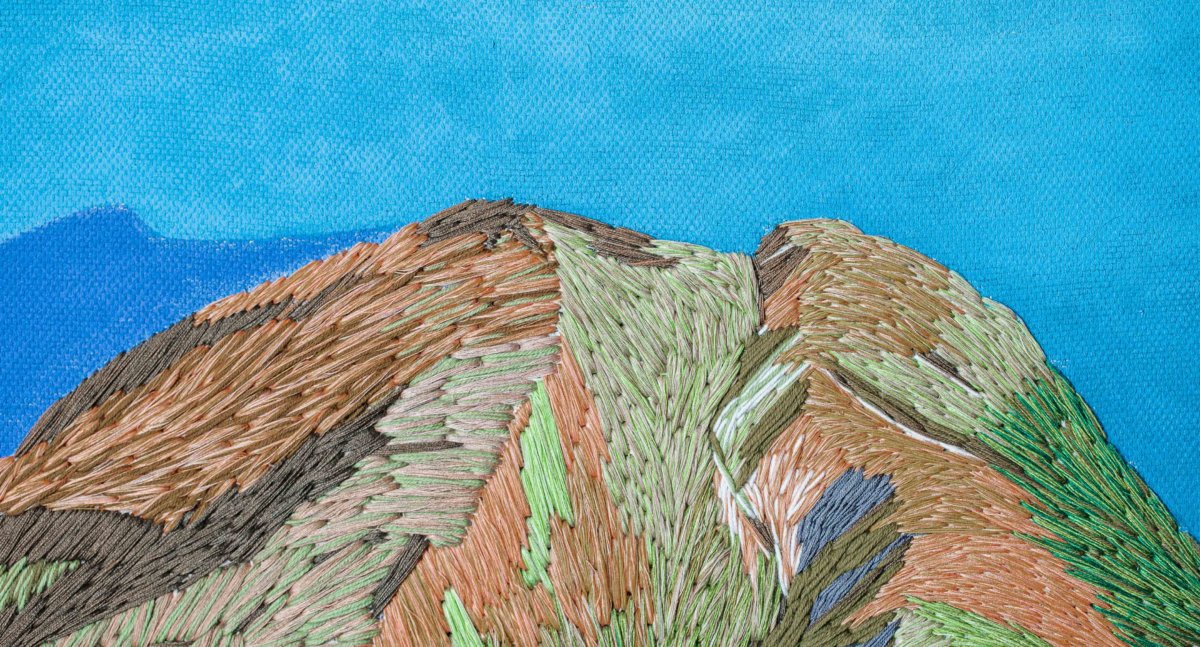


The Green Wall:
sharing the story of plants and The Mills with you
Since the beginning of the year, an elaborate and carefully constructed The Green Wall has been on display on 3/F. Composed of tree cotton, ramie plants, and 2 large pieces of hand embroidered art, the piece is aimed at highlighting the importance of plants.
Plants provide us with oxygen, materials, clothing, and an overall heightened sense of well-being. At The Mills, we have teamed up with curator Lab Pheno and botanist Forest Round Round to use cotton and linen in creating the embroidered art.
By displaying the raw materials and elaborate artwork created using cotton and linen, we hope that the The Green Wall gives visitors a better understanding and appreciation of all that plants provide us, now and throughout history.
At The Mills, we want to carry on our legacy as a former textile mill with a future of applied creativity and innovation, and continue to touch upon topics through an interesting and aesthetic way.



The Green Wall:
sharing the story of plants and The Mills with you
Since the beginning of the year, an elaborate and carefully constructed The Green Wall has been on display on 3/F. Composed of tree cotton, ramie plants, and 2 large pieces of hand embroidered art, the piece is aimed at highlighting the importance of plants.
Plants provide us with oxygen, materials, clothing, and an overall heightened sense of well-being. At The Mills, we have teamed up with curator Lab Pheno and botanist Forest Round Round to use cotton and linen in creating the embroidered art.
By displaying the raw materials and elaborate artwork created using cotton and linen, we hope that the The Green Wall gives visitors a better understanding and appreciation of all that plants provide us, now and throughout history.
At The Mills, we want to carry on our legacy as a former textile mill with a future of applied creativity and innovation, and continue to touch upon topics through an interesting and aesthetic way.



The Green Wall:
sharing the story of plants and The Mills with you
Since the beginning of the year, an elaborate and carefully constructed The Green Wall has been on display on 3/F. Composed of tree cotton, ramie plants, and 2 large pieces of hand embroidered art, the piece is aimed at highlighting the importance of plants.
Plants provide us with oxygen, materials, clothing, and an overall heightened sense of well-being. At The Mills, we have teamed up with curator Lab Pheno and botanist Forest Round Round to use cotton and linen in creating the embroidered art.
By displaying the raw materials and elaborate artwork created using cotton and linen, we hope that the The Green Wall gives visitors a better understanding and appreciation of all that plants provide us, now and throughout history.
At The Mills, we want to carry on our legacy as a former textile mill with a future of applied creativity and innovation, and continue to touch upon topics through an interesting and aesthetic way.
Unsung Hero
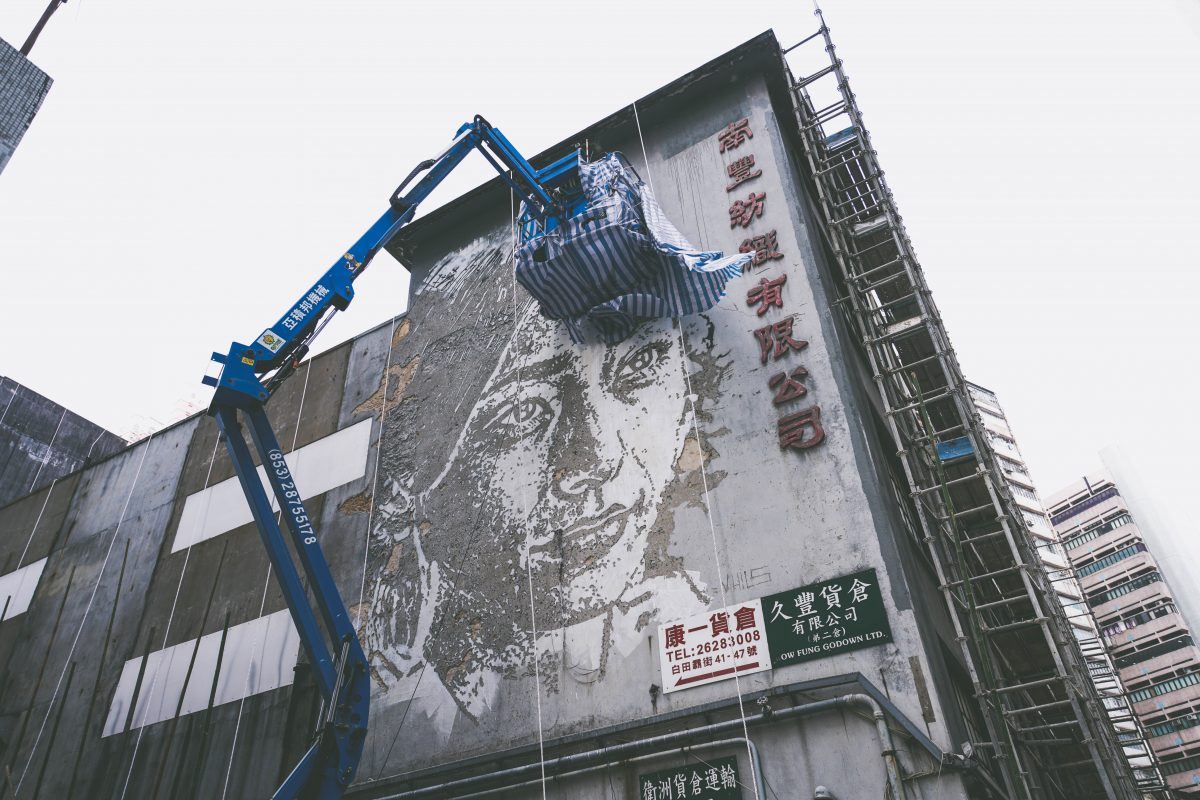


Created by celebrated Portuguese artist Alexandre Farto, internationally known under the alias Vhils, this monolithic portrait is realized through his signature medium, carving and drilling directly onto the preserved façade of the former Nan Fung Textiles. The title symbolizes the memories of a former generation that built Hong Kong’s history and economy.



Created by celebrated Portuguese artist Alexandre Farto, internationally known under the alias Vhils, this monolithic portrait is realized through his signature medium, carving and drilling directly onto the preserved façade of the former Nan Fung Textiles. The title symbolizes the memories of a former generation that built Hong Kong’s history and economy.



Created by celebrated Portuguese artist Alexandre Farto, internationally known under the alias Vhils, this monolithic portrait is realized through his signature medium, carving and drilling directly onto the preserved façade of the former Nan Fung Textiles. The title symbolizes the memories of a former generation that built Hong Kong’s history and economy.
Mural
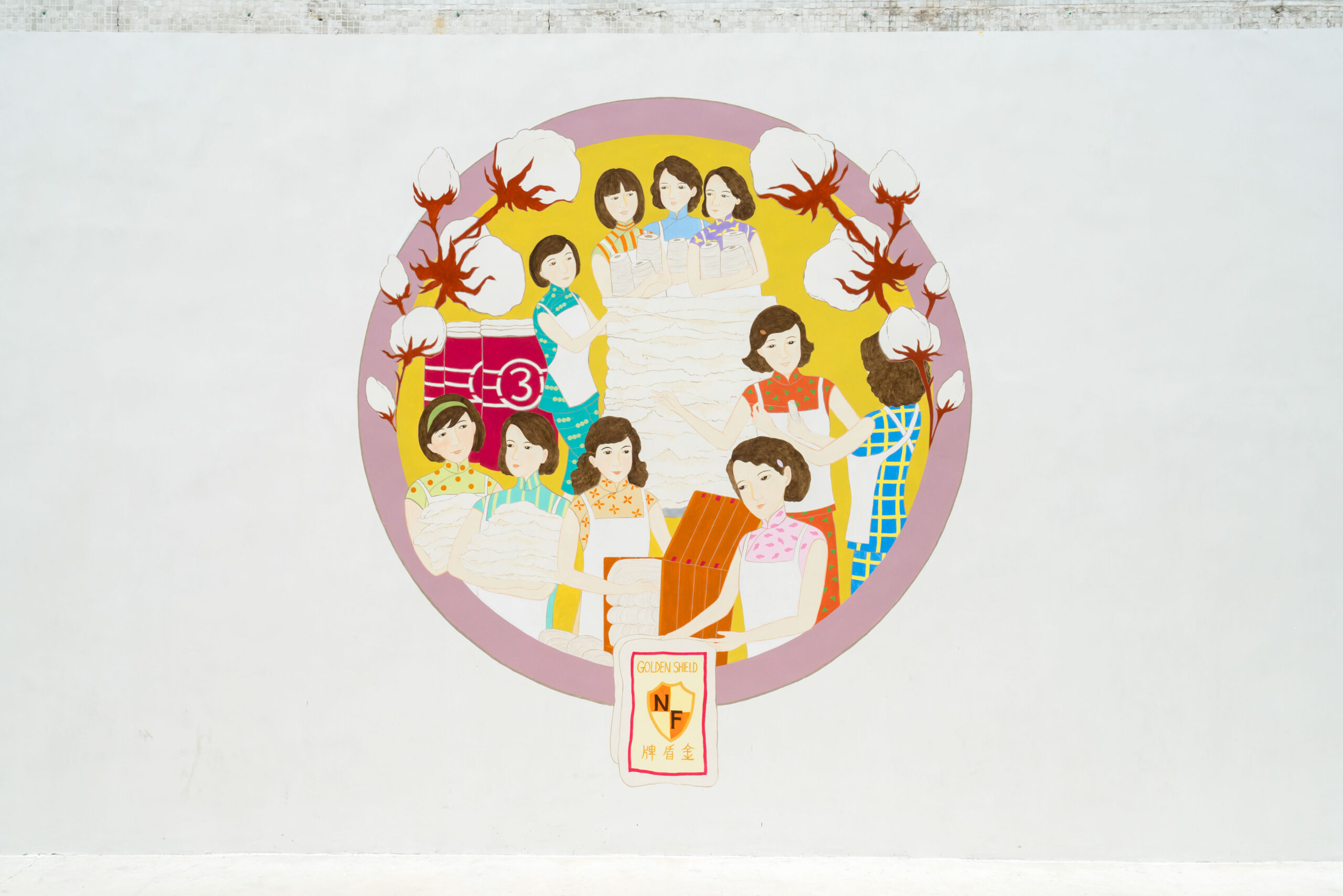


The Mills collaborated with Hong Kong Youth Arts Foundation and six local artists to create murals for an imaginative journey along Pak Tin Par Lane. Artists interpreted our past, present, and future, covering our signature brands, manufacturing processes and bright hopes for our future.
The Past and Future of The Mills
Uncle
The Nan Fung Cotton Mills thrived as Hong Kong’s textile industry flourished in the 60s. Since then, the company has led the development of local innovative industries to new heights. “The Past and Future of The Mills” celebrates the importance of striking a balance between creative development and resources conservation at The Mills
Cat’s Cradle
Wong Ting Fung
In the past, a pair of able hands was considered a person’s most important asset to make a living. “Cat’s Cradle” honours the important relationship between The Mills’ rich history and its present innovative endeavours. Using the childhood game of cat’s cradle to symbolise endless creativity, the past and present of the former cotton mills are forever interwoven, providing support and inspiration from both sides for future generations.
The Passage of Time
Keung Lap Yu, Candice
“The Passage of Time” features a printmaking style design on a vintage colour palette. The artwork illustrates the working environment in the former Nang Fung Cotton Mills. The design also is encircled by multicoloured lines, like cotton yarn, embracing the factory workers. By imprinting the past on the wall of this new landmark, “The Passage of Time” is a reminder to reminisce The Mills’ vibrant past.
The image of spinning female worker
Karen Pow
Historical photos from the former Nan Fung Cotton Mills showed that its factory workers were predominately female. They were highly skilled in the complex procedure of producing cotton yarn. The collective memory of these “factory girls” are celebrated in this artwork, delicately reimagined to echo the fine yarn that they had produced.
Continuity
Marka Mak
“Continuity” celebrates the entrepreneurial spirit of The Mills, and the brand’s deep-rooted aspiration for innovation. The artwork recreates an enlarged unfinished embroidery of the traditional Golden Cup brand through optical illusion. Visitors are encouraged to “take hold” of the giant needle as a symbolic gesture to support The Mills’ continuing mission to promote creativity and innovation for future generations.
Overgrown
Rebecca T Lin
“Overgrown” pays homage to the beautifully timeworn architecture at The Mills. The artwork depicts a soothing scene of overgrown plants weaving between tall pillars, exploring the idea of “what could have been” as an alternate outcome if the former cotton mills are left abandoned. At a time when technology is moving at lightning speed and everybody is looking down at their screens, “Overgrown” reminds viewers of their surroundings and the beauty in things from the past.
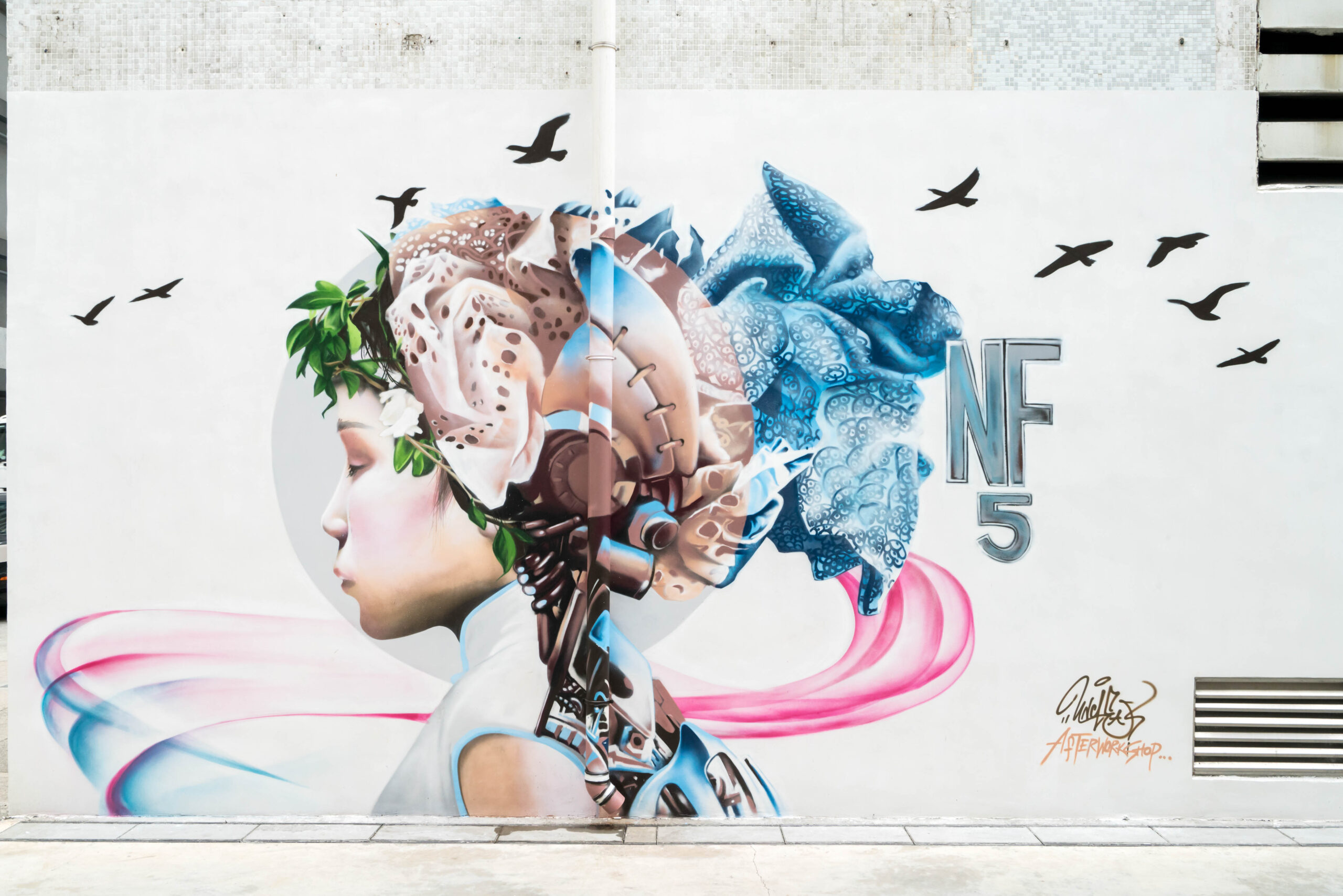


The Mills collaborated with Hong Kong Youth Arts Foundation and six local artists to create murals for an imaginative journey along Pak Tin Par Lane. Artists interpreted our past, present, and future, covering our signature brands, manufacturing processes and bright hopes for our future.
The Past and Future of The Mills
Uncle
The Nan Fung Cotton Mills thrived as Hong Kong’s textile industry flourished in the 60s. Since then, the company has led the development of local innovative industries to new heights. “The Past and Future of The Mills” celebrates the importance of striking a balance between creative development and resources conservation at The Mills
Cat’s Cradle
Wong Ting Fung
In the past, a pair of able hands was considered a person’s most important asset to make a living. “Cat’s Cradle” honours the important relationship between The Mills’ rich history and its present innovative endeavours. Using the childhood game of cat’s cradle to symbolise endless creativity, the past and present of the former cotton mills are forever interwoven, providing support and inspiration from both sides for future generations.
The Passage of Time
Keung Lap Yu, Candice
“The Passage of Time” features a printmaking style design on a vintage colour palette. The artwork illustrates the working environment in the former Nang Fung Cotton Mills. The design also is encircled by multicoloured lines, like cotton yarn, embracing the factory workers. By imprinting the past on the wall of this new landmark, “The Passage of Time” is a reminder to reminisce The Mills’ vibrant past.
The image of spinning female worker
Karen Pow
Historical photos from the former Nan Fung Cotton Mills showed that its factory workers were predominately female. They were highly skilled in the complex procedure of producing cotton yarn. The collective memory of these “factory girls” are celebrated in this artwork, delicately reimagined to echo the fine yarn that they had produced.
Continuity
Marka Mak
“Continuity” celebrates the entrepreneurial spirit of The Mills, and the brand’s deep-rooted aspiration for innovation. The artwork recreates an enlarged unfinished embroidery of the traditional Golden Cup brand through optical illusion. Visitors are encouraged to “take hold” of the giant needle as a symbolic gesture to support The Mills’ continuing mission to promote creativity and innovation for future generations.
Overgrown
Rebecca T Lin
“Overgrown” pays homage to the beautifully timeworn architecture at The Mills. The artwork depicts a soothing scene of overgrown plants weaving between tall pillars, exploring the idea of “what could have been” as an alternate outcome if the former cotton mills are left abandoned. At a time when technology is moving at lightning speed and everybody is looking down at their screens, “Overgrown” reminds viewers of their surroundings and the beauty in things from the past.



The Mills collaborated with Hong Kong Youth Arts Foundation and six local artists to create murals for an imaginative journey along Pak Tin Par Lane. Artists interpreted our past, present, and future, covering our signature brands, manufacturing processes and bright hopes for our future.
The Past and Future of The Mills
Uncle
The Nan Fung Cotton Mills thrived as Hong Kong’s textile industry flourished in the 60s. Since then, the company has led the development of local innovative industries to new heights. “The Past and Future of The Mills” celebrates the importance of striking a balance between creative development and resources conservation at The Mills
Cat’s Cradle
Wong Ting Fung
In the past, a pair of able hands was considered a person’s most important asset to make a living. “Cat’s Cradle” honours the important relationship between The Mills’ rich history and its present innovative endeavours. Using the childhood game of cat’s cradle to symbolise endless creativity, the past and present of the former cotton mills are forever interwoven, providing support and inspiration from both sides for future generations.
The Passage of Time
Keung Lap Yu, Candice
“The Passage of Time” features a printmaking style design on a vintage colour palette. The artwork illustrates the working environment in the former Nang Fung Cotton Mills. The design also is encircled by multicoloured lines, like cotton yarn, embracing the factory workers. By imprinting the past on the wall of this new landmark, “The Passage of Time” is a reminder to reminisce The Mills’ vibrant past.
The image of spinning female worker
Karen Pow
Historical photos from the former Nan Fung Cotton Mills showed that its factory workers were predominately female. They were highly skilled in the complex procedure of producing cotton yarn. The collective memory of these “factory girls” are celebrated in this artwork, delicately reimagined to echo the fine yarn that they had produced.
Continuity
Marka Mak
“Continuity” celebrates the entrepreneurial spirit of The Mills, and the brand’s deep-rooted aspiration for innovation. The artwork recreates an enlarged unfinished embroidery of the traditional Golden Cup brand through optical illusion. Visitors are encouraged to “take hold” of the giant needle as a symbolic gesture to support The Mills’ continuing mission to promote creativity and innovation for future generations.
Overgrown
Rebecca T Lin
“Overgrown” pays homage to the beautifully timeworn architecture at The Mills. The artwork depicts a soothing scene of overgrown plants weaving between tall pillars, exploring the idea of “what could have been” as an alternate outcome if the former cotton mills are left abandoned. At a time when technology is moving at lightning speed and everybody is looking down at their screens, “Overgrown” reminds viewers of their surroundings and the beauty in things from the past.
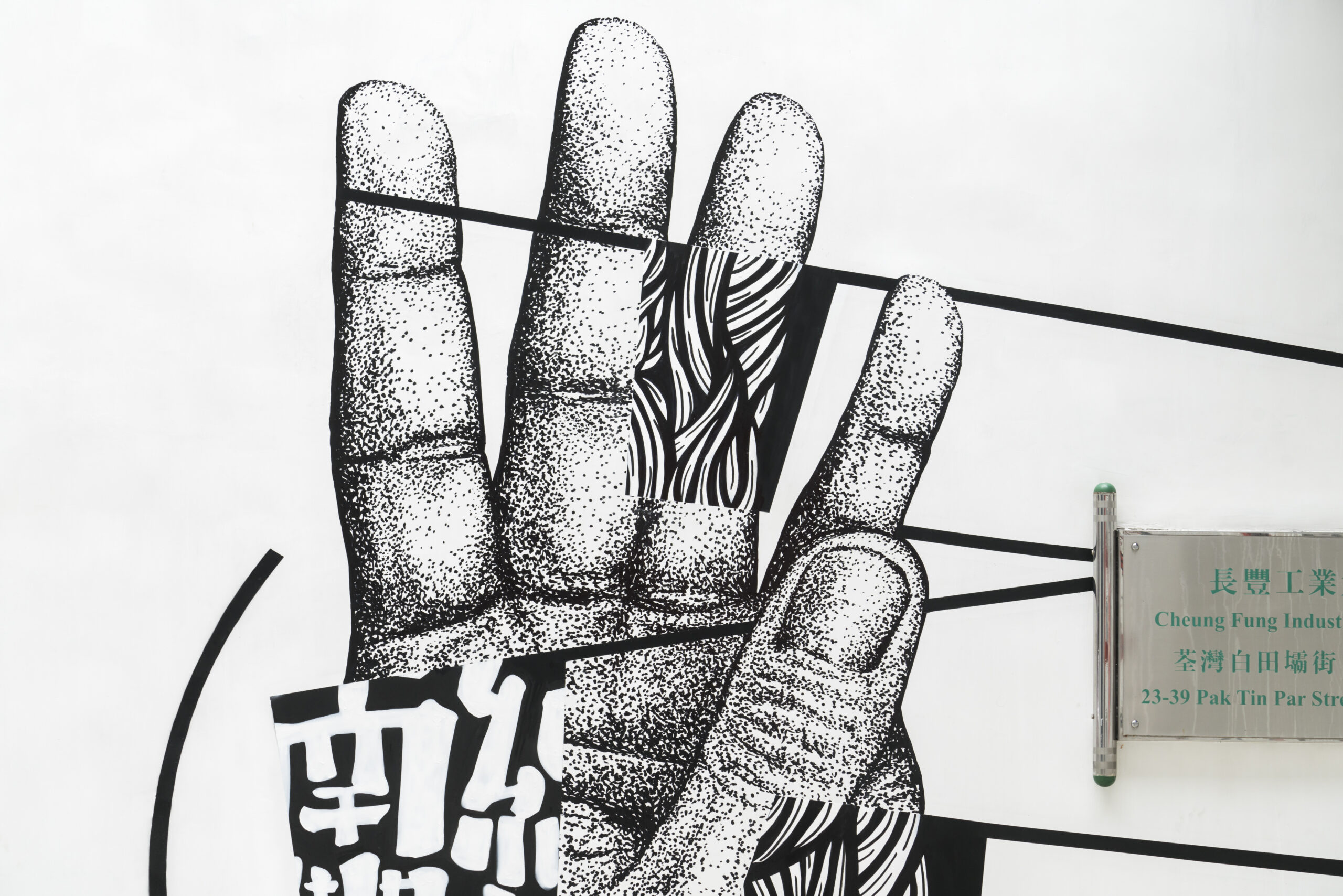


The Mills collaborated with Hong Kong Youth Arts Foundation and six local artists to create murals for an imaginative journey along Pak Tin Par Lane. Artists interpreted our past, present, and future, covering our signature brands, manufacturing processes and bright hopes for our future.
The Past and Future of The Mills
Uncle
The Nan Fung Cotton Mills thrived as Hong Kong’s textile industry flourished in the 60s. Since then, the company has led the development of local innovative industries to new heights. “The Past and Future of The Mills” celebrates the importance of striking a balance between creative development and resources conservation at The Mills
Cat’s Cradle
Wong Ting Fung
In the past, a pair of able hands was considered a person’s most important asset to make a living. “Cat’s Cradle” honours the important relationship between The Mills’ rich history and its present innovative endeavours. Using the childhood game of cat’s cradle to symbolise endless creativity, the past and present of the former cotton mills are forever interwoven, providing support and inspiration from both sides for future generations.
The Passage of Time
Keung Lap Yu, Candice
“The Passage of Time” features a printmaking style design on a vintage colour palette. The artwork illustrates the working environment in the former Nang Fung Cotton Mills. The design also is encircled by multicoloured lines, like cotton yarn, embracing the factory workers. By imprinting the past on the wall of this new landmark, “The Passage of Time” is a reminder to reminisce The Mills’ vibrant past.
The image of spinning female worker
Karen Pow
Historical photos from the former Nan Fung Cotton Mills showed that its factory workers were predominately female. They were highly skilled in the complex procedure of producing cotton yarn. The collective memory of these “factory girls” are celebrated in this artwork, delicately reimagined to echo the fine yarn that they had produced.
Continuity
Marka Mak
“Continuity” celebrates the entrepreneurial spirit of The Mills, and the brand’s deep-rooted aspiration for innovation. The artwork recreates an enlarged unfinished embroidery of the traditional Golden Cup brand through optical illusion. Visitors are encouraged to “take hold” of the giant needle as a symbolic gesture to support The Mills’ continuing mission to promote creativity and innovation for future generations.
Overgrown
Rebecca T Lin
“Overgrown” pays homage to the beautifully timeworn architecture at The Mills. The artwork depicts a soothing scene of overgrown plants weaving between tall pillars, exploring the idea of “what could have been” as an alternate outcome if the former cotton mills are left abandoned. At a time when technology is moving at lightning speed and everybody is looking down at their screens, “Overgrown” reminds viewers of their surroundings and the beauty in things from the past.
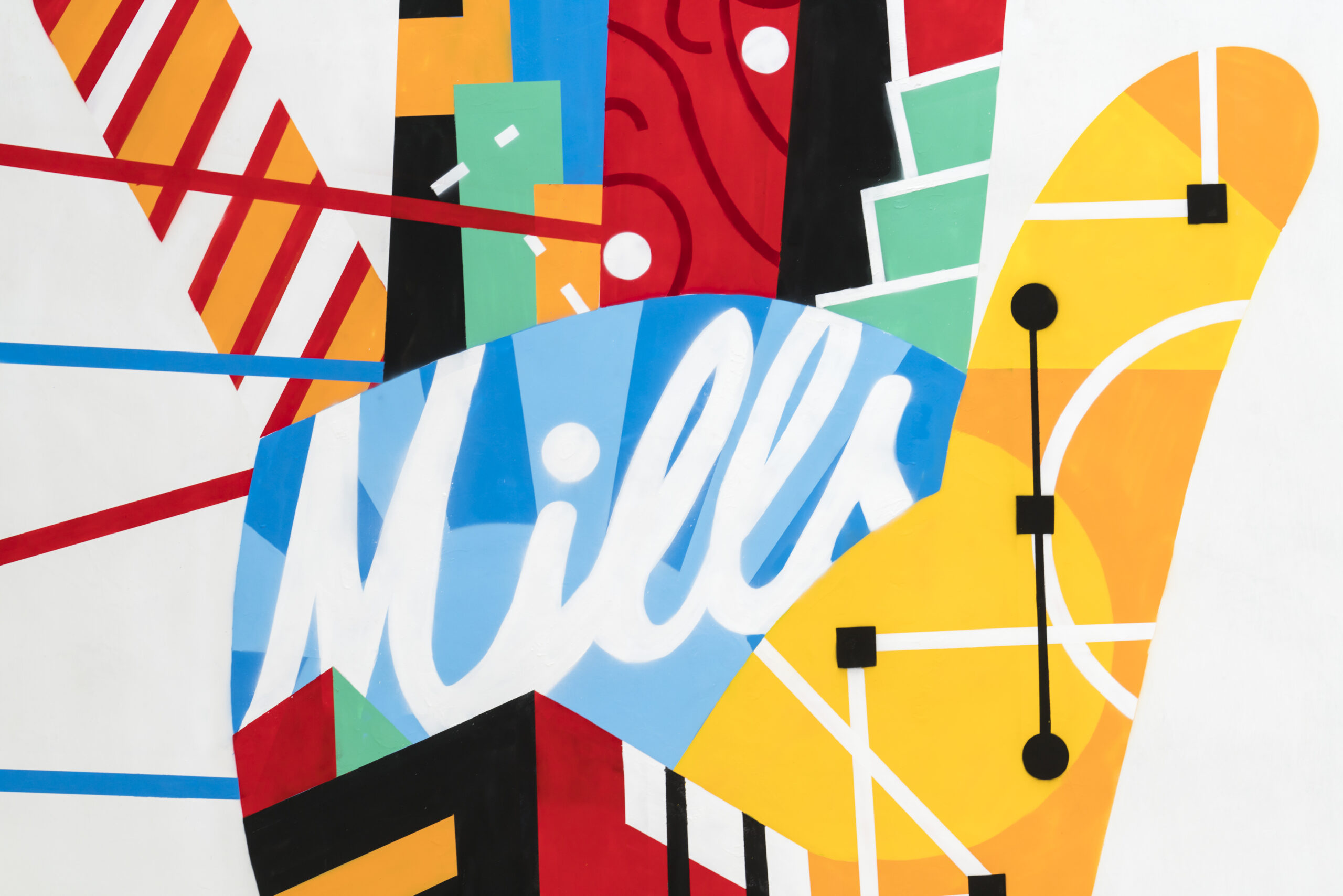


The Mills collaborated with Hong Kong Youth Arts Foundation and six local artists to create murals for an imaginative journey along Pak Tin Par Lane. Artists interpreted our past, present, and future, covering our signature brands, manufacturing processes and bright hopes for our future.
The Past and Future of The Mills
Uncle
The Nan Fung Cotton Mills thrived as Hong Kong’s textile industry flourished in the 60s. Since then, the company has led the development of local innovative industries to new heights. “The Past and Future of The Mills” celebrates the importance of striking a balance between creative development and resources conservation at The Mills
Cat’s Cradle
Wong Ting Fung
In the past, a pair of able hands was considered a person’s most important asset to make a living. “Cat’s Cradle” honours the important relationship between The Mills’ rich history and its present innovative endeavours. Using the childhood game of cat’s cradle to symbolise endless creativity, the past and present of the former cotton mills are forever interwoven, providing support and inspiration from both sides for future generations.
The Passage of Time
Keung Lap Yu, Candice
“The Passage of Time” features a printmaking style design on a vintage colour palette. The artwork illustrates the working environment in the former Nang Fung Cotton Mills. The design also is encircled by multicoloured lines, like cotton yarn, embracing the factory workers. By imprinting the past on the wall of this new landmark, “The Passage of Time” is a reminder to reminisce The Mills’ vibrant past.
The image of spinning female worker
Karen Pow
Historical photos from the former Nan Fung Cotton Mills showed that its factory workers were predominately female. They were highly skilled in the complex procedure of producing cotton yarn. The collective memory of these “factory girls” are celebrated in this artwork, delicately reimagined to echo the fine yarn that they had produced.
Continuity
Marka Mak
“Continuity” celebrates the entrepreneurial spirit of The Mills, and the brand’s deep-rooted aspiration for innovation. The artwork recreates an enlarged unfinished embroidery of the traditional Golden Cup brand through optical illusion. Visitors are encouraged to “take hold” of the giant needle as a symbolic gesture to support The Mills’ continuing mission to promote creativity and innovation for future generations.
Overgrown
Rebecca T Lin
“Overgrown” pays homage to the beautifully timeworn architecture at The Mills. The artwork depicts a soothing scene of overgrown plants weaving between tall pillars, exploring the idea of “what could have been” as an alternate outcome if the former cotton mills are left abandoned. At a time when technology is moving at lightning speed and everybody is looking down at their screens, “Overgrown” reminds viewers of their surroundings and the beauty in things from the past.
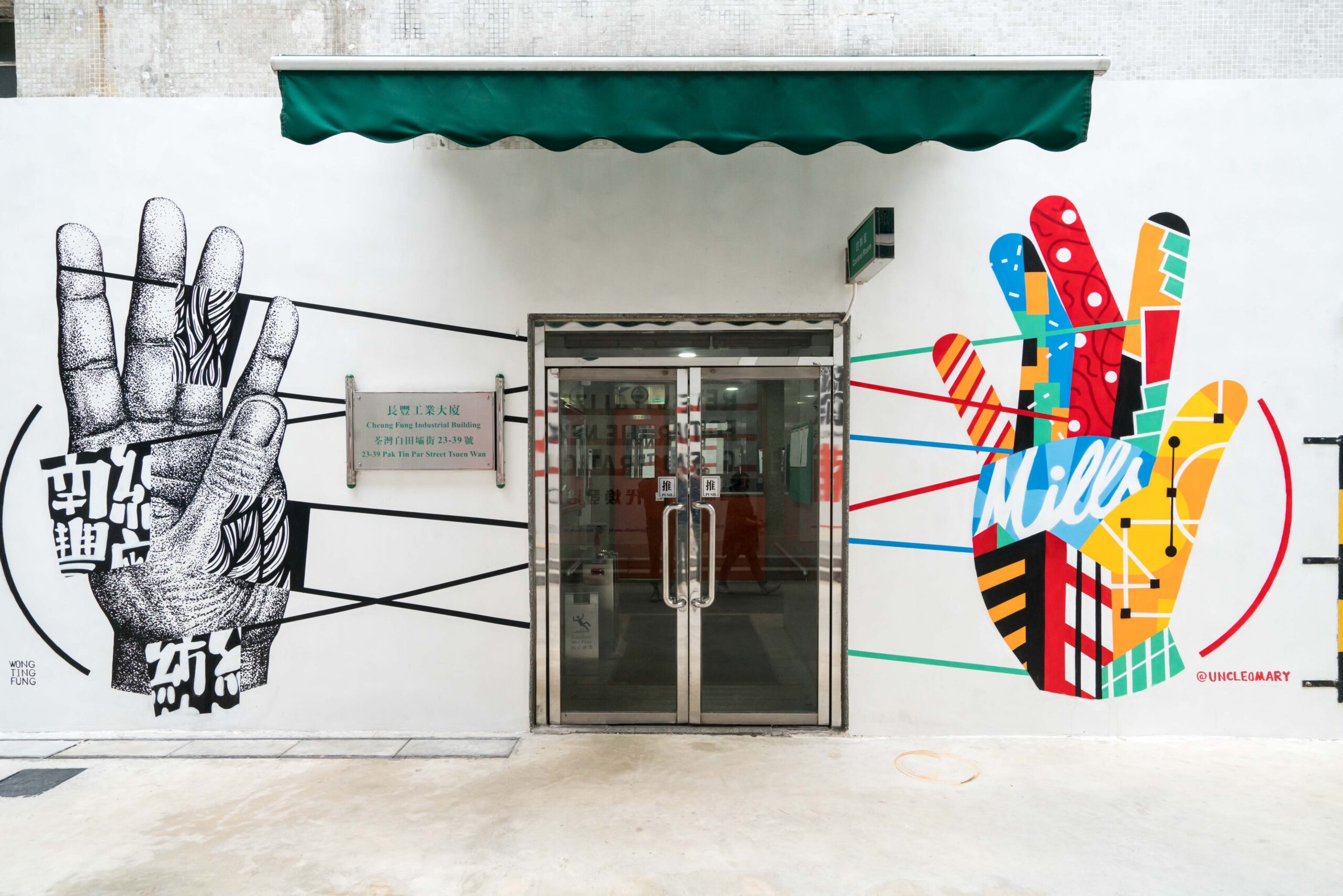


The Mills collaborated with Hong Kong Youth Arts Foundation and six local artists to create murals for an imaginative journey along Pak Tin Par Lane. Artists interpreted our past, present, and future, covering our signature brands, manufacturing processes and bright hopes for our future.
The Past and Future of The Mills
Uncle
The Nan Fung Cotton Mills thrived as Hong Kong’s textile industry flourished in the 60s. Since then, the company has led the development of local innovative industries to new heights. “The Past and Future of The Mills” celebrates the importance of striking a balance between creative development and resources conservation at The Mills
Cat’s Cradle
Wong Ting Fung
In the past, a pair of able hands was considered a person’s most important asset to make a living. “Cat’s Cradle” honours the important relationship between The Mills’ rich history and its present innovative endeavours. Using the childhood game of cat’s cradle to symbolise endless creativity, the past and present of the former cotton mills are forever interwoven, providing support and inspiration from both sides for future generations.
The Passage of Time
Keung Lap Yu, Candice
“The Passage of Time” features a printmaking style design on a vintage colour palette. The artwork illustrates the working environment in the former Nang Fung Cotton Mills. The design also is encircled by multicoloured lines, like cotton yarn, embracing the factory workers. By imprinting the past on the wall of this new landmark, “The Passage of Time” is a reminder to reminisce The Mills’ vibrant past.
The image of spinning female worker
Karen Pow
Historical photos from the former Nan Fung Cotton Mills showed that its factory workers were predominately female. They were highly skilled in the complex procedure of producing cotton yarn. The collective memory of these “factory girls” are celebrated in this artwork, delicately reimagined to echo the fine yarn that they had produced.
Continuity
Marka Mak
“Continuity” celebrates the entrepreneurial spirit of The Mills, and the brand’s deep-rooted aspiration for innovation. The artwork recreates an enlarged unfinished embroidery of the traditional Golden Cup brand through optical illusion. Visitors are encouraged to “take hold” of the giant needle as a symbolic gesture to support The Mills’ continuing mission to promote creativity and innovation for future generations.
Overgrown
Rebecca T Lin
“Overgrown” pays homage to the beautifully timeworn architecture at The Mills. The artwork depicts a soothing scene of overgrown plants weaving between tall pillars, exploring the idea of “what could have been” as an alternate outcome if the former cotton mills are left abandoned. At a time when technology is moving at lightning speed and everybody is looking down at their screens, “Overgrown” reminds viewers of their surroundings and the beauty in things from the past.
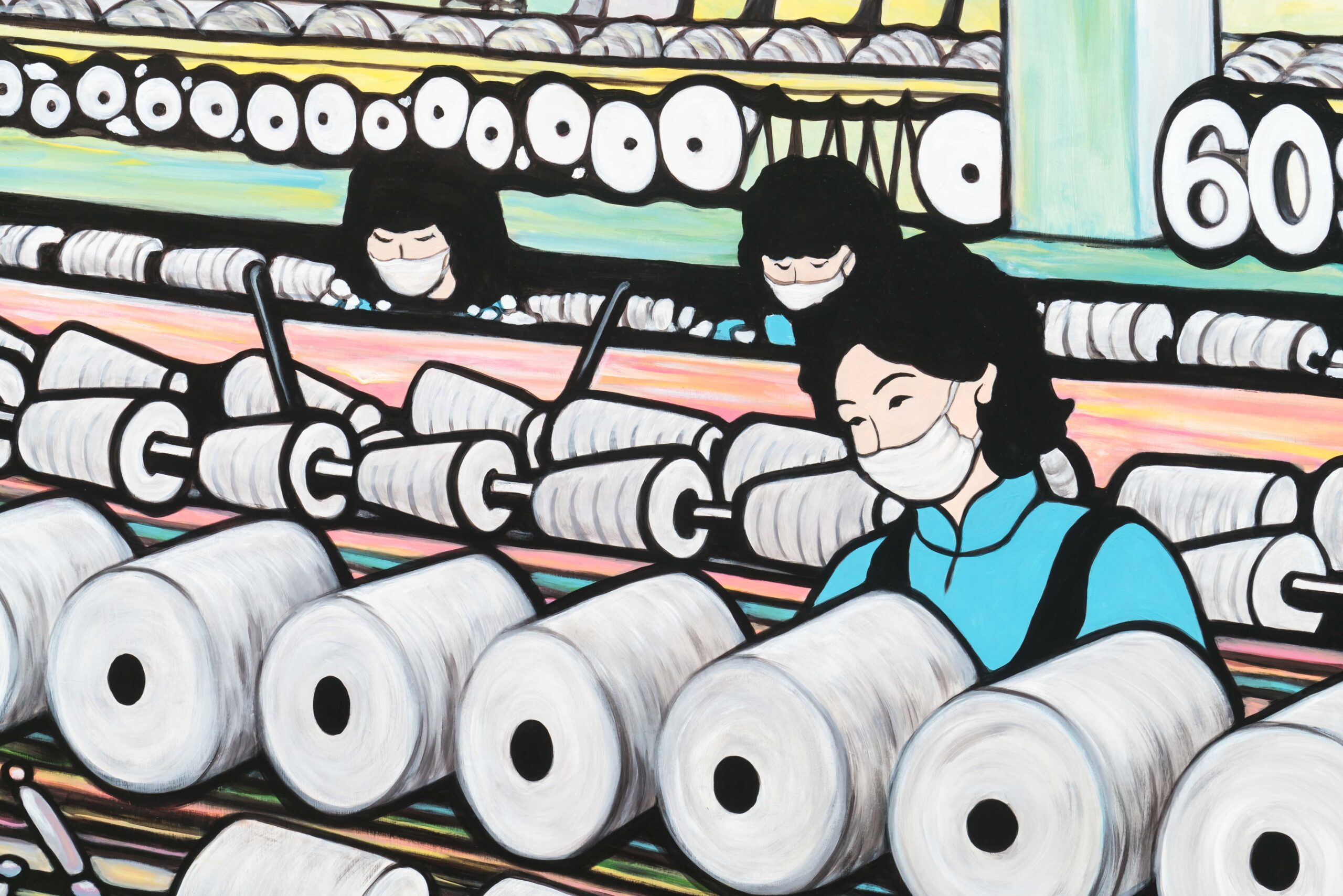


The Mills collaborated with Hong Kong Youth Arts Foundation and six local artists to create murals for an imaginative journey along Pak Tin Par Lane. Artists interpreted our past, present, and future, covering our signature brands, manufacturing processes and bright hopes for our future.
The Past and Future of The Mills
Uncle
The Nan Fung Cotton Mills thrived as Hong Kong’s textile industry flourished in the 60s. Since then, the company has led the development of local innovative industries to new heights. “The Past and Future of The Mills” celebrates the importance of striking a balance between creative development and resources conservation at The Mills
Cat’s Cradle
Wong Ting Fung
In the past, a pair of able hands was considered a person’s most important asset to make a living. “Cat’s Cradle” honours the important relationship between The Mills’ rich history and its present innovative endeavours. Using the childhood game of cat’s cradle to symbolise endless creativity, the past and present of the former cotton mills are forever interwoven, providing support and inspiration from both sides for future generations.
The Passage of Time
Keung Lap Yu, Candice
“The Passage of Time” features a printmaking style design on a vintage colour palette. The artwork illustrates the working environment in the former Nang Fung Cotton Mills. The design also is encircled by multicoloured lines, like cotton yarn, embracing the factory workers. By imprinting the past on the wall of this new landmark, “The Passage of Time” is a reminder to reminisce The Mills’ vibrant past.
The image of spinning female worker
Karen Pow
Historical photos from the former Nan Fung Cotton Mills showed that its factory workers were predominately female. They were highly skilled in the complex procedure of producing cotton yarn. The collective memory of these “factory girls” are celebrated in this artwork, delicately reimagined to echo the fine yarn that they had produced.
Continuity
Marka Mak
“Continuity” celebrates the entrepreneurial spirit of The Mills, and the brand’s deep-rooted aspiration for innovation. The artwork recreates an enlarged unfinished embroidery of the traditional Golden Cup brand through optical illusion. Visitors are encouraged to “take hold” of the giant needle as a symbolic gesture to support The Mills’ continuing mission to promote creativity and innovation for future generations.
Overgrown
Rebecca T Lin
“Overgrown” pays homage to the beautifully timeworn architecture at The Mills. The artwork depicts a soothing scene of overgrown plants weaving between tall pillars, exploring the idea of “what could have been” as an alternate outcome if the former cotton mills are left abandoned. At a time when technology is moving at lightning speed and everybody is looking down at their screens, “Overgrown” reminds viewers of their surroundings and the beauty in things from the past.
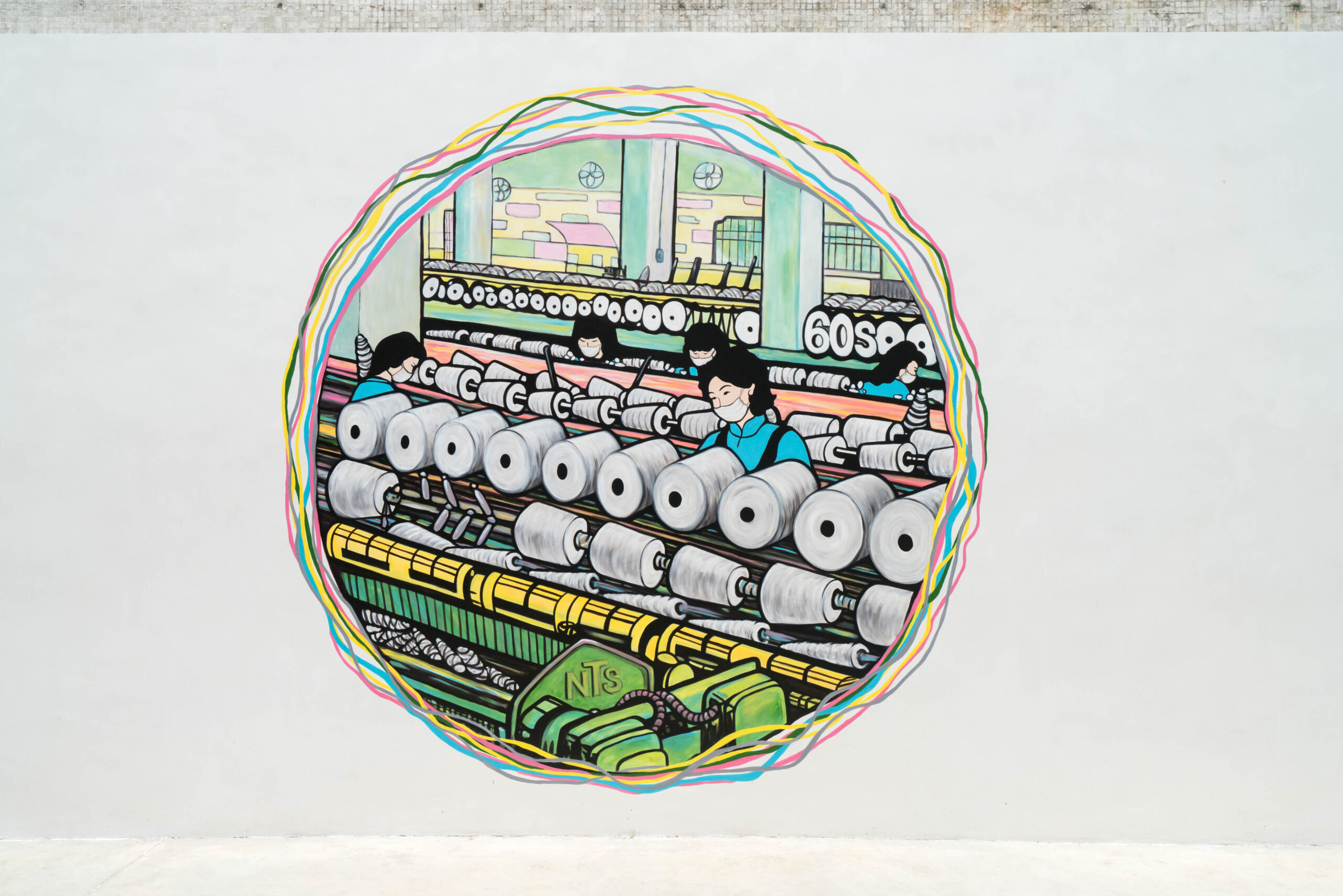


The Mills collaborated with Hong Kong Youth Arts Foundation and six local artists to create murals for an imaginative journey along Pak Tin Par Lane. Artists interpreted our past, present, and future, covering our signature brands, manufacturing processes and bright hopes for our future.
The Past and Future of The Mills
Uncle
The Nan Fung Cotton Mills thrived as Hong Kong’s textile industry flourished in the 60s. Since then, the company has led the development of local innovative industries to new heights. “The Past and Future of The Mills” celebrates the importance of striking a balance between creative development and resources conservation at The Mills
Cat’s Cradle
Wong Ting Fung
In the past, a pair of able hands was considered a person’s most important asset to make a living. “Cat’s Cradle” honours the important relationship between The Mills’ rich history and its present innovative endeavours. Using the childhood game of cat’s cradle to symbolise endless creativity, the past and present of the former cotton mills are forever interwoven, providing support and inspiration from both sides for future generations.
The Passage of Time
Keung Lap Yu, Candice
“The Passage of Time” features a printmaking style design on a vintage colour palette. The artwork illustrates the working environment in the former Nang Fung Cotton Mills. The design also is encircled by multicoloured lines, like cotton yarn, embracing the factory workers. By imprinting the past on the wall of this new landmark, “The Passage of Time” is a reminder to reminisce The Mills’ vibrant past.
The image of spinning female worker
Karen Pow
Historical photos from the former Nan Fung Cotton Mills showed that its factory workers were predominately female. They were highly skilled in the complex procedure of producing cotton yarn. The collective memory of these “factory girls” are celebrated in this artwork, delicately reimagined to echo the fine yarn that they had produced.
Continuity
Marka Mak
“Continuity” celebrates the entrepreneurial spirit of The Mills, and the brand’s deep-rooted aspiration for innovation. The artwork recreates an enlarged unfinished embroidery of the traditional Golden Cup brand through optical illusion. Visitors are encouraged to “take hold” of the giant needle as a symbolic gesture to support The Mills’ continuing mission to promote creativity and innovation for future generations.
Overgrown
Rebecca T Lin
“Overgrown” pays homage to the beautifully timeworn architecture at The Mills. The artwork depicts a soothing scene of overgrown plants weaving between tall pillars, exploring the idea of “what could have been” as an alternate outcome if the former cotton mills are left abandoned. At a time when technology is moving at lightning speed and everybody is looking down at their screens, “Overgrown” reminds viewers of their surroundings and the beauty in things from the past.
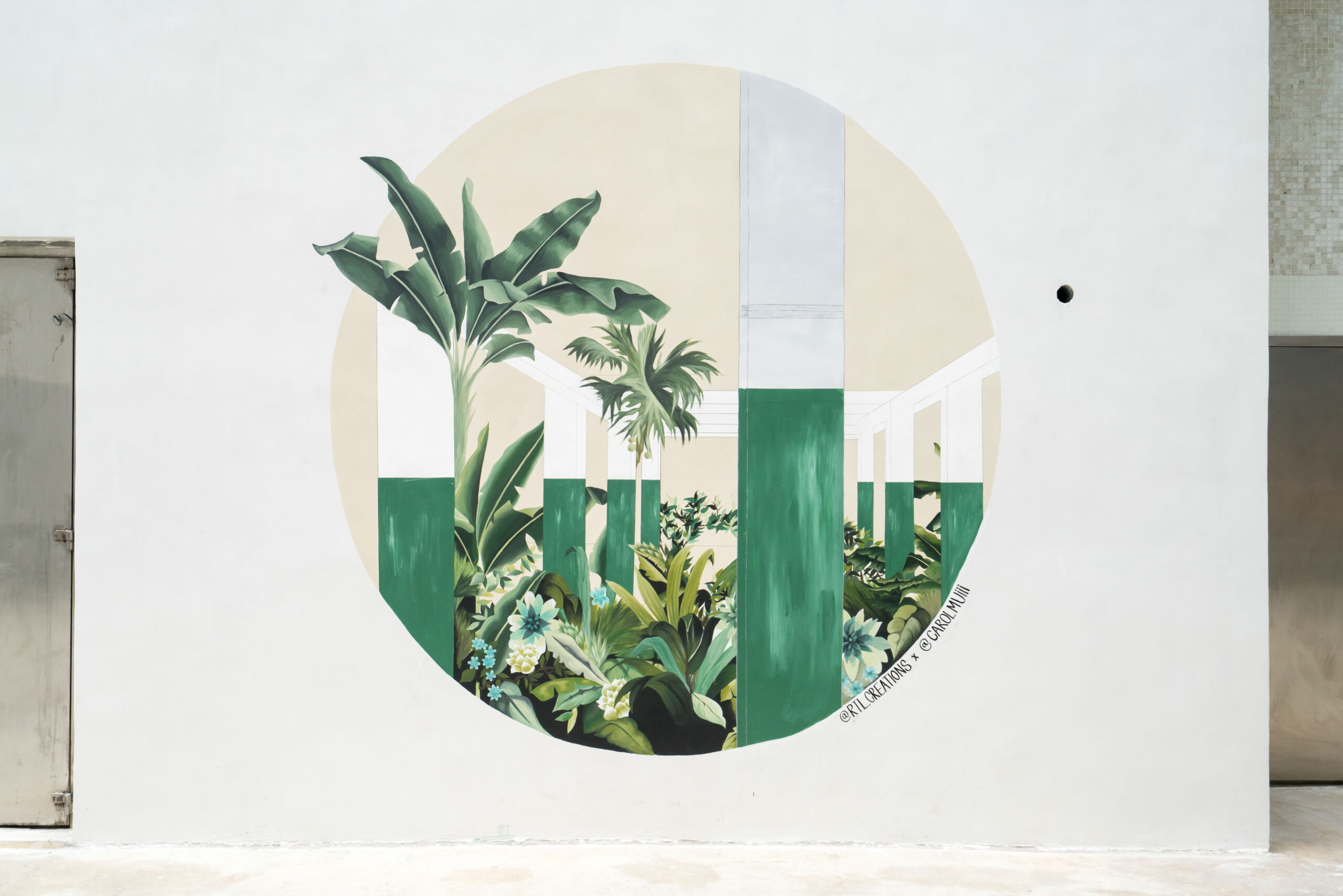


The Mills collaborated with Hong Kong Youth Arts Foundation and six local artists to create murals for an imaginative journey along Pak Tin Par Lane. Artists interpreted our past, present, and future, covering our signature brands, manufacturing processes and bright hopes for our future.
The Past and Future of The Mills
Uncle
The Nan Fung Cotton Mills thrived as Hong Kong’s textile industry flourished in the 60s. Since then, the company has led the development of local innovative industries to new heights. “The Past and Future of The Mills” celebrates the importance of striking a balance between creative development and resources conservation at The Mills
Cat’s Cradle
Wong Ting Fung
In the past, a pair of able hands was considered a person’s most important asset to make a living. “Cat’s Cradle” honours the important relationship between The Mills’ rich history and its present innovative endeavours. Using the childhood game of cat’s cradle to symbolise endless creativity, the past and present of the former cotton mills are forever interwoven, providing support and inspiration from both sides for future generations.
The Passage of Time
Keung Lap Yu, Candice
“The Passage of Time” features a printmaking style design on a vintage colour palette. The artwork illustrates the working environment in the former Nang Fung Cotton Mills. The design also is encircled by multicoloured lines, like cotton yarn, embracing the factory workers. By imprinting the past on the wall of this new landmark, “The Passage of Time” is a reminder to reminisce The Mills’ vibrant past.
The image of spinning female worker
Karen Pow
Historical photos from the former Nan Fung Cotton Mills showed that its factory workers were predominately female. They were highly skilled in the complex procedure of producing cotton yarn. The collective memory of these “factory girls” are celebrated in this artwork, delicately reimagined to echo the fine yarn that they had produced.
Continuity
Marka Mak
“Continuity” celebrates the entrepreneurial spirit of The Mills, and the brand’s deep-rooted aspiration for innovation. The artwork recreates an enlarged unfinished embroidery of the traditional Golden Cup brand through optical illusion. Visitors are encouraged to “take hold” of the giant needle as a symbolic gesture to support The Mills’ continuing mission to promote creativity and innovation for future generations.
Overgrown
Rebecca T Lin
“Overgrown” pays homage to the beautifully timeworn architecture at The Mills. The artwork depicts a soothing scene of overgrown plants weaving between tall pillars, exploring the idea of “what could have been” as an alternate outcome if the former cotton mills are left abandoned. At a time when technology is moving at lightning speed and everybody is looking down at their screens, “Overgrown” reminds viewers of their surroundings and the beauty in things from the past.
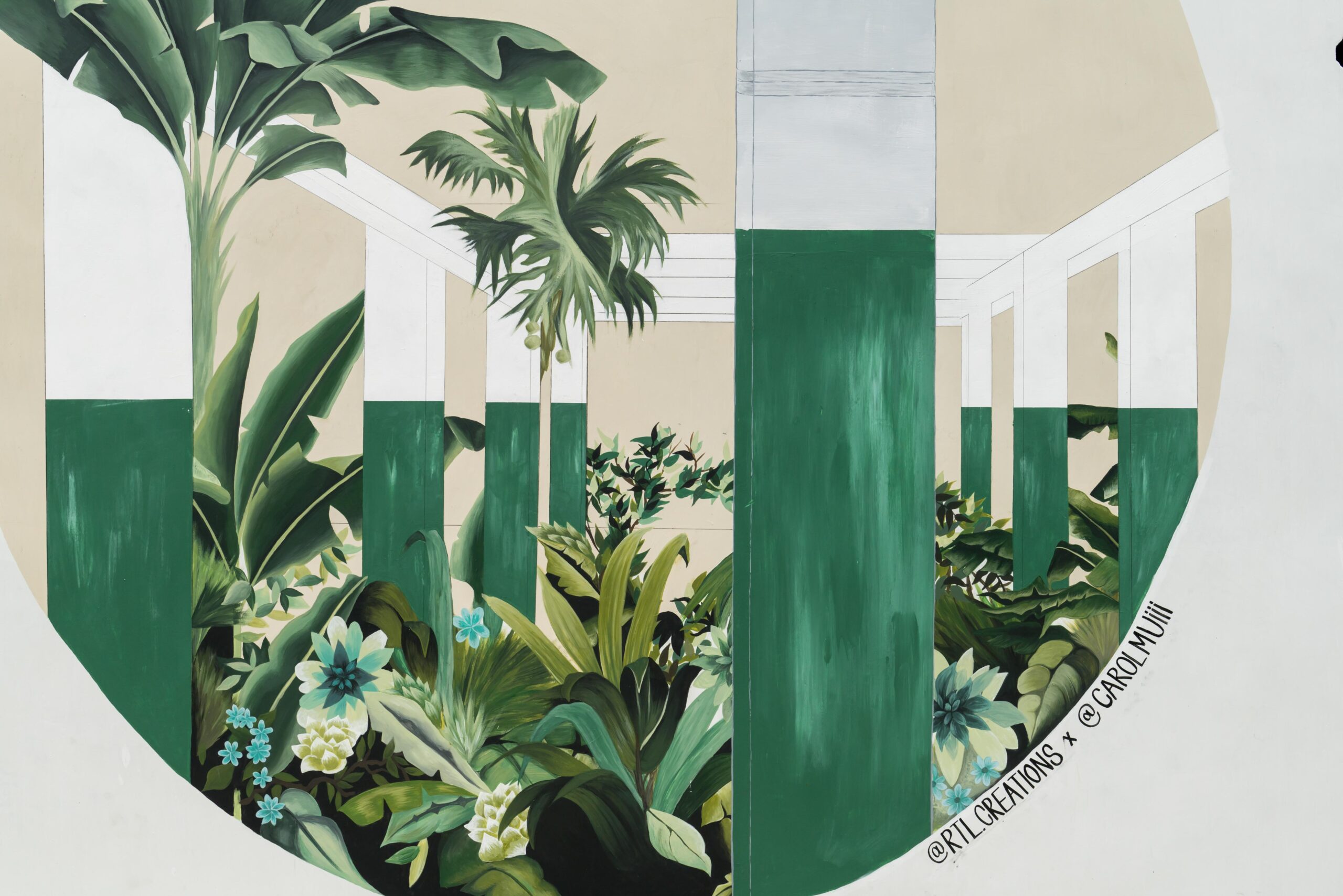


The Mills collaborated with Hong Kong Youth Arts Foundation and six local artists to create murals for an imaginative journey along Pak Tin Par Lane. Artists interpreted our past, present, and future, covering our signature brands, manufacturing processes and bright hopes for our future.
The Past and Future of The Mills
Uncle
The Nan Fung Cotton Mills thrived as Hong Kong’s textile industry flourished in the 60s. Since then, the company has led the development of local innovative industries to new heights. “The Past and Future of The Mills” celebrates the importance of striking a balance between creative development and resources conservation at The Mills
Cat’s Cradle
Wong Ting Fung
In the past, a pair of able hands was considered a person’s most important asset to make a living. “Cat’s Cradle” honours the important relationship between The Mills’ rich history and its present innovative endeavours. Using the childhood game of cat’s cradle to symbolise endless creativity, the past and present of the former cotton mills are forever interwoven, providing support and inspiration from both sides for future generations.
The Passage of Time
Keung Lap Yu, Candice
“The Passage of Time” features a printmaking style design on a vintage colour palette. The artwork illustrates the working environment in the former Nang Fung Cotton Mills. The design also is encircled by multicoloured lines, like cotton yarn, embracing the factory workers. By imprinting the past on the wall of this new landmark, “The Passage of Time” is a reminder to reminisce The Mills’ vibrant past.
The image of spinning female worker
Karen Pow
Historical photos from the former Nan Fung Cotton Mills showed that its factory workers were predominately female. They were highly skilled in the complex procedure of producing cotton yarn. The collective memory of these “factory girls” are celebrated in this artwork, delicately reimagined to echo the fine yarn that they had produced.
Continuity
Marka Mak
“Continuity” celebrates the entrepreneurial spirit of The Mills, and the brand’s deep-rooted aspiration for innovation. The artwork recreates an enlarged unfinished embroidery of the traditional Golden Cup brand through optical illusion. Visitors are encouraged to “take hold” of the giant needle as a symbolic gesture to support The Mills’ continuing mission to promote creativity and innovation for future generations.
Overgrown
Rebecca T Lin
“Overgrown” pays homage to the beautifully timeworn architecture at The Mills. The artwork depicts a soothing scene of overgrown plants weaving between tall pillars, exploring the idea of “what could have been” as an alternate outcome if the former cotton mills are left abandoned. At a time when technology is moving at lightning speed and everybody is looking down at their screens, “Overgrown” reminds viewers of their surroundings and the beauty in things from the past.
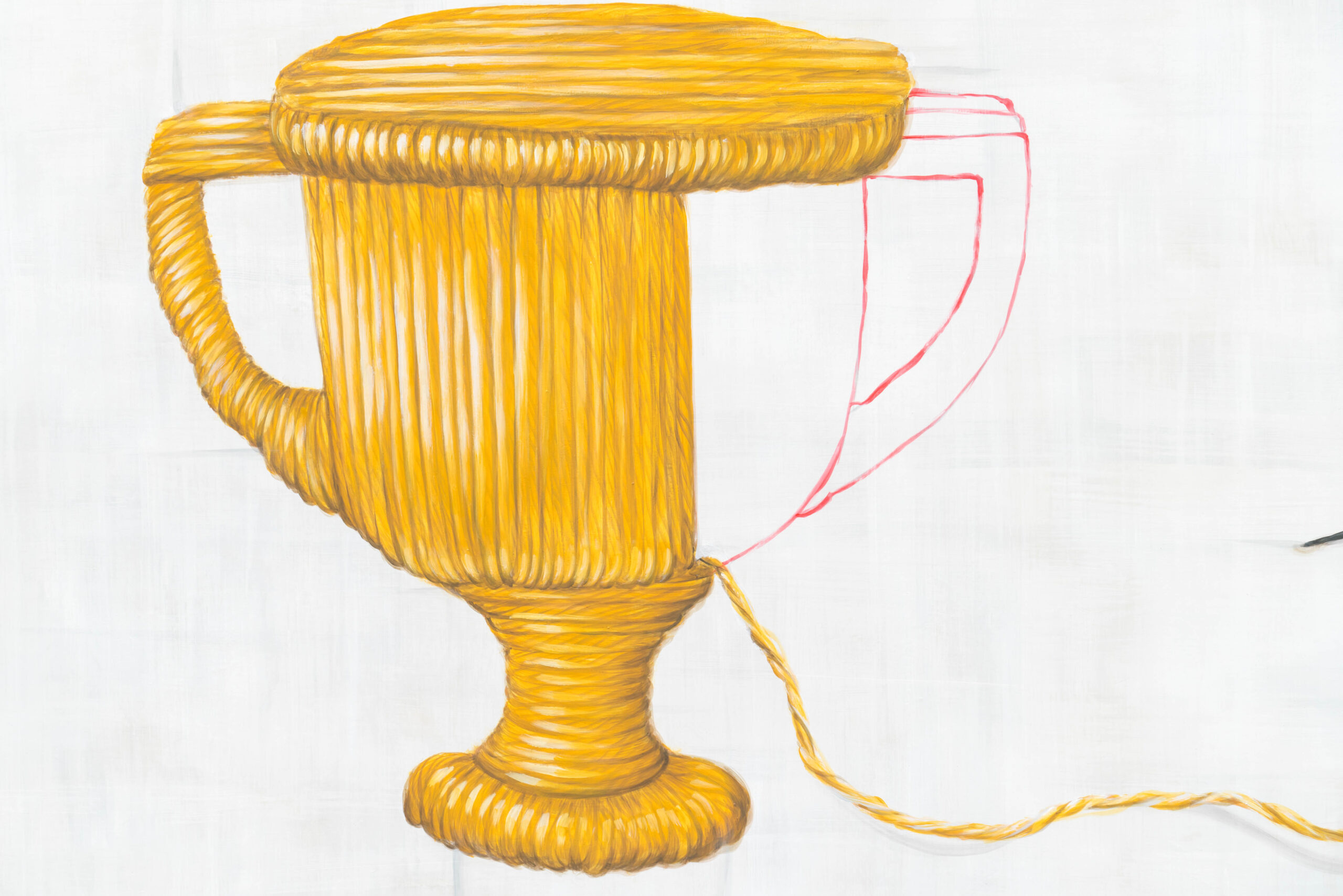


The Mills collaborated with Hong Kong Youth Arts Foundation and six local artists to create murals for an imaginative journey along Pak Tin Par Lane. Artists interpreted our past, present, and future, covering our signature brands, manufacturing processes and bright hopes for our future.
The Past and Future of The Mills
Uncle
The Nan Fung Cotton Mills thrived as Hong Kong’s textile industry flourished in the 60s. Since then, the company has led the development of local innovative industries to new heights. “The Past and Future of The Mills” celebrates the importance of striking a balance between creative development and resources conservation at The Mills
Cat’s Cradle
Wong Ting Fung
In the past, a pair of able hands was considered a person’s most important asset to make a living. “Cat’s Cradle” honours the important relationship between The Mills’ rich history and its present innovative endeavours. Using the childhood game of cat’s cradle to symbolise endless creativity, the past and present of the former cotton mills are forever interwoven, providing support and inspiration from both sides for future generations.
The Passage of Time
Keung Lap Yu, Candice
“The Passage of Time” features a printmaking style design on a vintage colour palette. The artwork illustrates the working environment in the former Nang Fung Cotton Mills. The design also is encircled by multicoloured lines, like cotton yarn, embracing the factory workers. By imprinting the past on the wall of this new landmark, “The Passage of Time” is a reminder to reminisce The Mills’ vibrant past.
The image of spinning female worker
Karen Pow
Historical photos from the former Nan Fung Cotton Mills showed that its factory workers were predominately female. They were highly skilled in the complex procedure of producing cotton yarn. The collective memory of these “factory girls” are celebrated in this artwork, delicately reimagined to echo the fine yarn that they had produced.
Continuity
Marka Mak
“Continuity” celebrates the entrepreneurial spirit of The Mills, and the brand’s deep-rooted aspiration for innovation. The artwork recreates an enlarged unfinished embroidery of the traditional Golden Cup brand through optical illusion. Visitors are encouraged to “take hold” of the giant needle as a symbolic gesture to support The Mills’ continuing mission to promote creativity and innovation for future generations.
Overgrown
Rebecca T Lin
“Overgrown” pays homage to the beautifully timeworn architecture at The Mills. The artwork depicts a soothing scene of overgrown plants weaving between tall pillars, exploring the idea of “what could have been” as an alternate outcome if the former cotton mills are left abandoned. At a time when technology is moving at lightning speed and everybody is looking down at their screens, “Overgrown” reminds viewers of their surroundings and the beauty in things from the past.
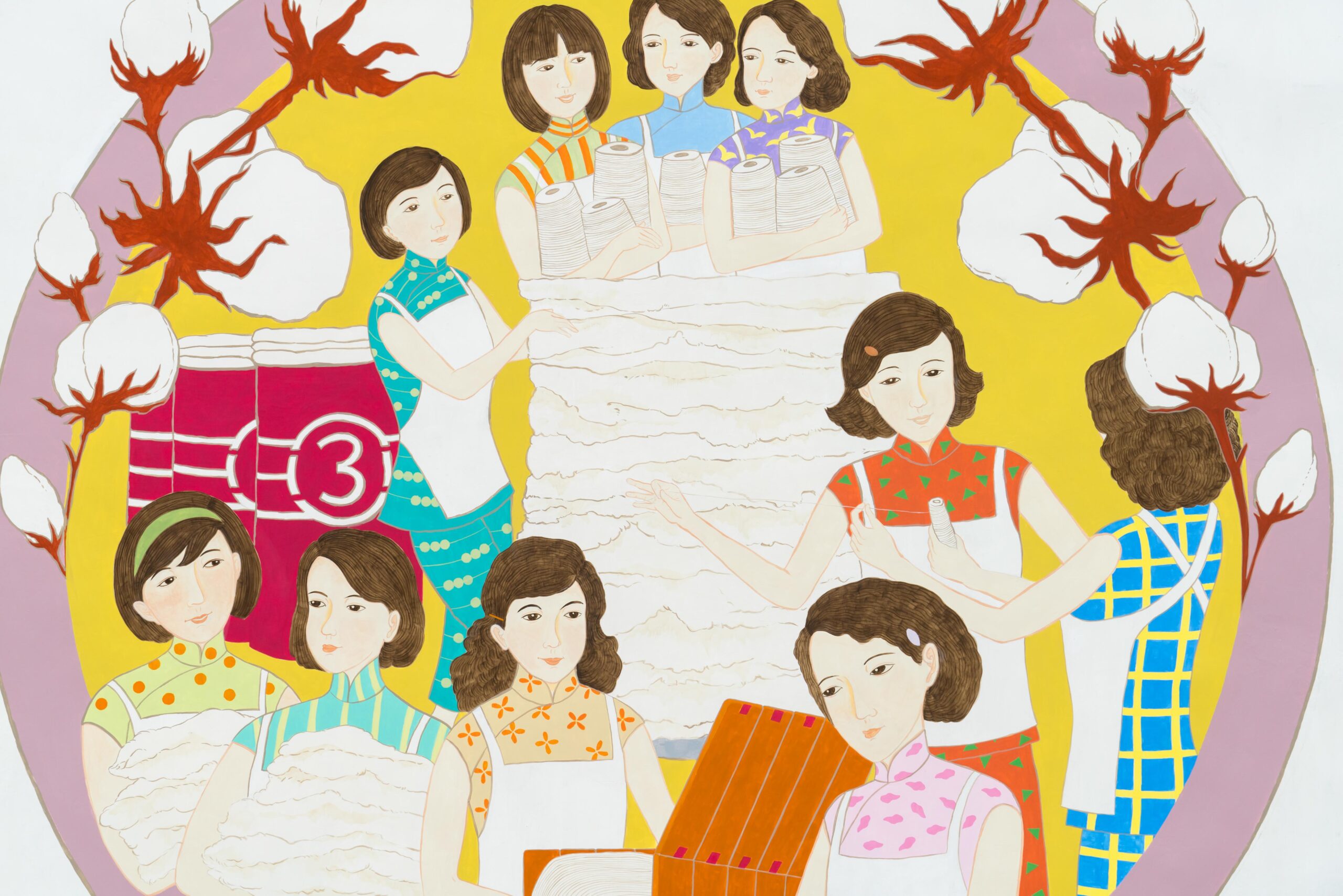


The Mills collaborated with Hong Kong Youth Arts Foundation and six local artists to create murals for an imaginative journey along Pak Tin Par Lane. Artists interpreted our past, present, and future, covering our signature brands, manufacturing processes and bright hopes for our future.
The Past and Future of The Mills
Uncle
The Nan Fung Cotton Mills thrived as Hong Kong’s textile industry flourished in the 60s. Since then, the company has led the development of local innovative industries to new heights. “The Past and Future of The Mills” celebrates the importance of striking a balance between creative development and resources conservation at The Mills
Cat’s Cradle
Wong Ting Fung
In the past, a pair of able hands was considered a person’s most important asset to make a living. “Cat’s Cradle” honours the important relationship between The Mills’ rich history and its present innovative endeavours. Using the childhood game of cat’s cradle to symbolise endless creativity, the past and present of the former cotton mills are forever interwoven, providing support and inspiration from both sides for future generations.
The Passage of Time
Keung Lap Yu, Candice
“The Passage of Time” features a printmaking style design on a vintage colour palette. The artwork illustrates the working environment in the former Nang Fung Cotton Mills. The design also is encircled by multicoloured lines, like cotton yarn, embracing the factory workers. By imprinting the past on the wall of this new landmark, “The Passage of Time” is a reminder to reminisce The Mills’ vibrant past.
The image of spinning female worker
Karen Pow
Historical photos from the former Nan Fung Cotton Mills showed that its factory workers were predominately female. They were highly skilled in the complex procedure of producing cotton yarn. The collective memory of these “factory girls” are celebrated in this artwork, delicately reimagined to echo the fine yarn that they had produced.
Continuity
Marka Mak
“Continuity” celebrates the entrepreneurial spirit of The Mills, and the brand’s deep-rooted aspiration for innovation. The artwork recreates an enlarged unfinished embroidery of the traditional Golden Cup brand through optical illusion. Visitors are encouraged to “take hold” of the giant needle as a symbolic gesture to support The Mills’ continuing mission to promote creativity and innovation for future generations.
Overgrown
Rebecca T Lin
“Overgrown” pays homage to the beautifully timeworn architecture at The Mills. The artwork depicts a soothing scene of overgrown plants weaving between tall pillars, exploring the idea of “what could have been” as an alternate outcome if the former cotton mills are left abandoned. At a time when technology is moving at lightning speed and everybody is looking down at their screens, “Overgrown” reminds viewers of their surroundings and the beauty in things from the past.



The Mills collaborated with Hong Kong Youth Arts Foundation and six local artists to create murals for an imaginative journey along Pak Tin Par Lane. Artists interpreted our past, present, and future, covering our signature brands, manufacturing processes and bright hopes for our future.
The Past and Future of The Mills
Uncle
The Nan Fung Cotton Mills thrived as Hong Kong’s textile industry flourished in the 60s. Since then, the company has led the development of local innovative industries to new heights. “The Past and Future of The Mills” celebrates the importance of striking a balance between creative development and resources conservation at The Mills
Cat’s Cradle
Wong Ting Fung
In the past, a pair of able hands was considered a person’s most important asset to make a living. “Cat’s Cradle” honours the important relationship between The Mills’ rich history and its present innovative endeavours. Using the childhood game of cat’s cradle to symbolise endless creativity, the past and present of the former cotton mills are forever interwoven, providing support and inspiration from both sides for future generations.
The Passage of Time
Keung Lap Yu, Candice
“The Passage of Time” features a printmaking style design on a vintage colour palette. The artwork illustrates the working environment in the former Nang Fung Cotton Mills. The design also is encircled by multicoloured lines, like cotton yarn, embracing the factory workers. By imprinting the past on the wall of this new landmark, “The Passage of Time” is a reminder to reminisce The Mills’ vibrant past.
The image of spinning female worker
Karen Pow
Historical photos from the former Nan Fung Cotton Mills showed that its factory workers were predominately female. They were highly skilled in the complex procedure of producing cotton yarn. The collective memory of these “factory girls” are celebrated in this artwork, delicately reimagined to echo the fine yarn that they had produced.
Continuity
Marka Mak
“Continuity” celebrates the entrepreneurial spirit of The Mills, and the brand’s deep-rooted aspiration for innovation. The artwork recreates an enlarged unfinished embroidery of the traditional Golden Cup brand through optical illusion. Visitors are encouraged to “take hold” of the giant needle as a symbolic gesture to support The Mills’ continuing mission to promote creativity and innovation for future generations.
Overgrown
Rebecca T Lin
“Overgrown” pays homage to the beautifully timeworn architecture at The Mills. The artwork depicts a soothing scene of overgrown plants weaving between tall pillars, exploring the idea of “what could have been” as an alternate outcome if the former cotton mills are left abandoned. At a time when technology is moving at lightning speed and everybody is looking down at their screens, “Overgrown” reminds viewers of their surroundings and the beauty in things from the past.



The Mills collaborated with Hong Kong Youth Arts Foundation and six local artists to create murals for an imaginative journey along Pak Tin Par Lane. Artists interpreted our past, present, and future, covering our signature brands, manufacturing processes and bright hopes for our future.
The Past and Future of The Mills
Uncle
The Nan Fung Cotton Mills thrived as Hong Kong’s textile industry flourished in the 60s. Since then, the company has led the development of local innovative industries to new heights. “The Past and Future of The Mills” celebrates the importance of striking a balance between creative development and resources conservation at The Mills
Cat’s Cradle
Wong Ting Fung
In the past, a pair of able hands was considered a person’s most important asset to make a living. “Cat’s Cradle” honours the important relationship between The Mills’ rich history and its present innovative endeavours. Using the childhood game of cat’s cradle to symbolise endless creativity, the past and present of the former cotton mills are forever interwoven, providing support and inspiration from both sides for future generations.
The Passage of Time
Keung Lap Yu, Candice
“The Passage of Time” features a printmaking style design on a vintage colour palette. The artwork illustrates the working environment in the former Nang Fung Cotton Mills. The design also is encircled by multicoloured lines, like cotton yarn, embracing the factory workers. By imprinting the past on the wall of this new landmark, “The Passage of Time” is a reminder to reminisce The Mills’ vibrant past.
The image of spinning female worker
Karen Pow
Historical photos from the former Nan Fung Cotton Mills showed that its factory workers were predominately female. They were highly skilled in the complex procedure of producing cotton yarn. The collective memory of these “factory girls” are celebrated in this artwork, delicately reimagined to echo the fine yarn that they had produced.
Continuity
Marka Mak
“Continuity” celebrates the entrepreneurial spirit of The Mills, and the brand’s deep-rooted aspiration for innovation. The artwork recreates an enlarged unfinished embroidery of the traditional Golden Cup brand through optical illusion. Visitors are encouraged to “take hold” of the giant needle as a symbolic gesture to support The Mills’ continuing mission to promote creativity and innovation for future generations.
Overgrown
Rebecca T Lin
“Overgrown” pays homage to the beautifully timeworn architecture at The Mills. The artwork depicts a soothing scene of overgrown plants weaving between tall pillars, exploring the idea of “what could have been” as an alternate outcome if the former cotton mills are left abandoned. At a time when technology is moving at lightning speed and everybody is looking down at their screens, “Overgrown” reminds viewers of their surroundings and the beauty in things from the past.
The Weaving Wall
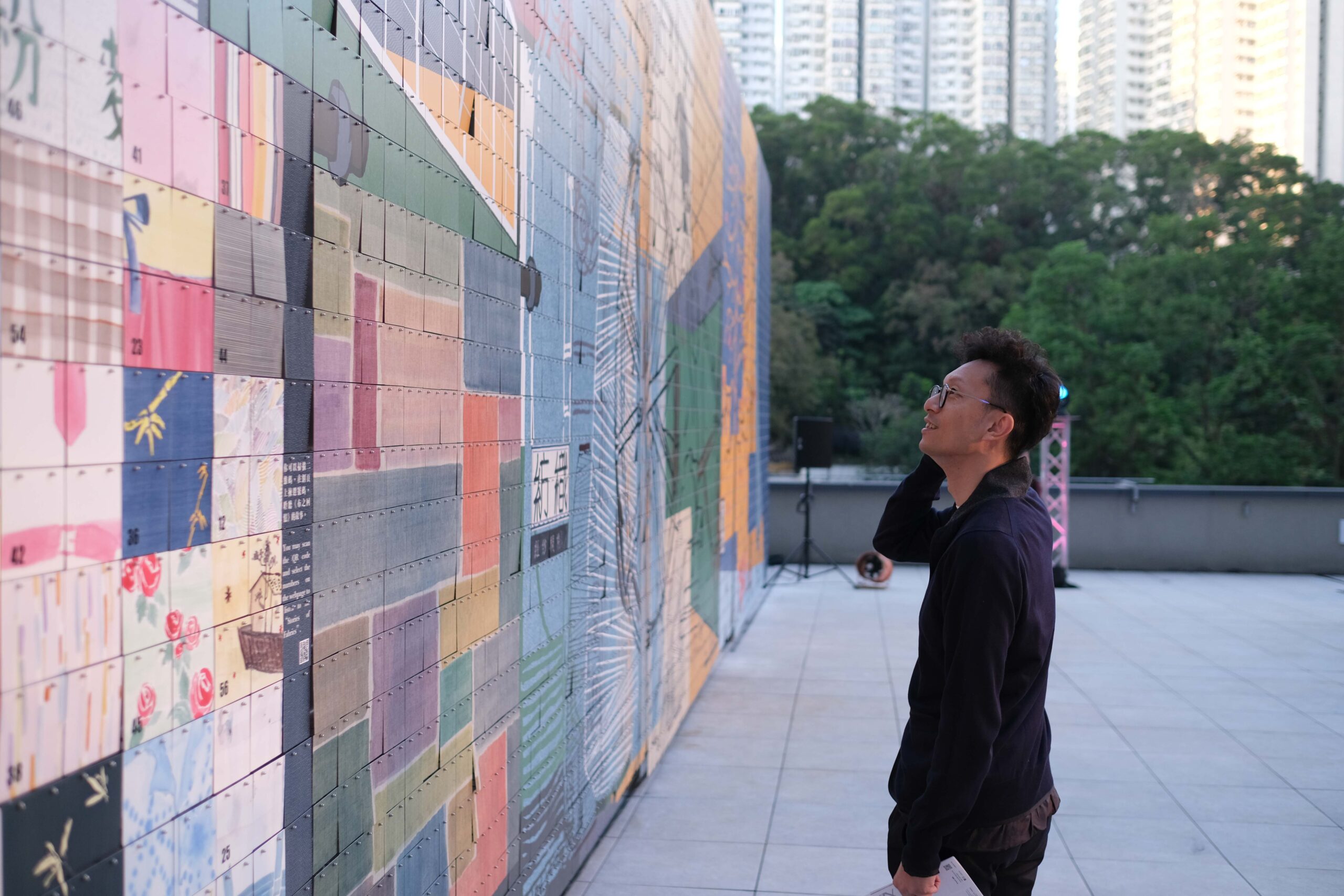


The Weaving Wall base on Chan Wai’s ‘Memory in Spring’ . Visual artist UUendy Lau and the weaving art team Breakthrough Arts Studio to draw and weave, presenting the story between sewing worker and the city she loves.
“I watched the factories sprouting like bamboo shoots after the rain. Your hands weave the prosperity and blooming of this city.”
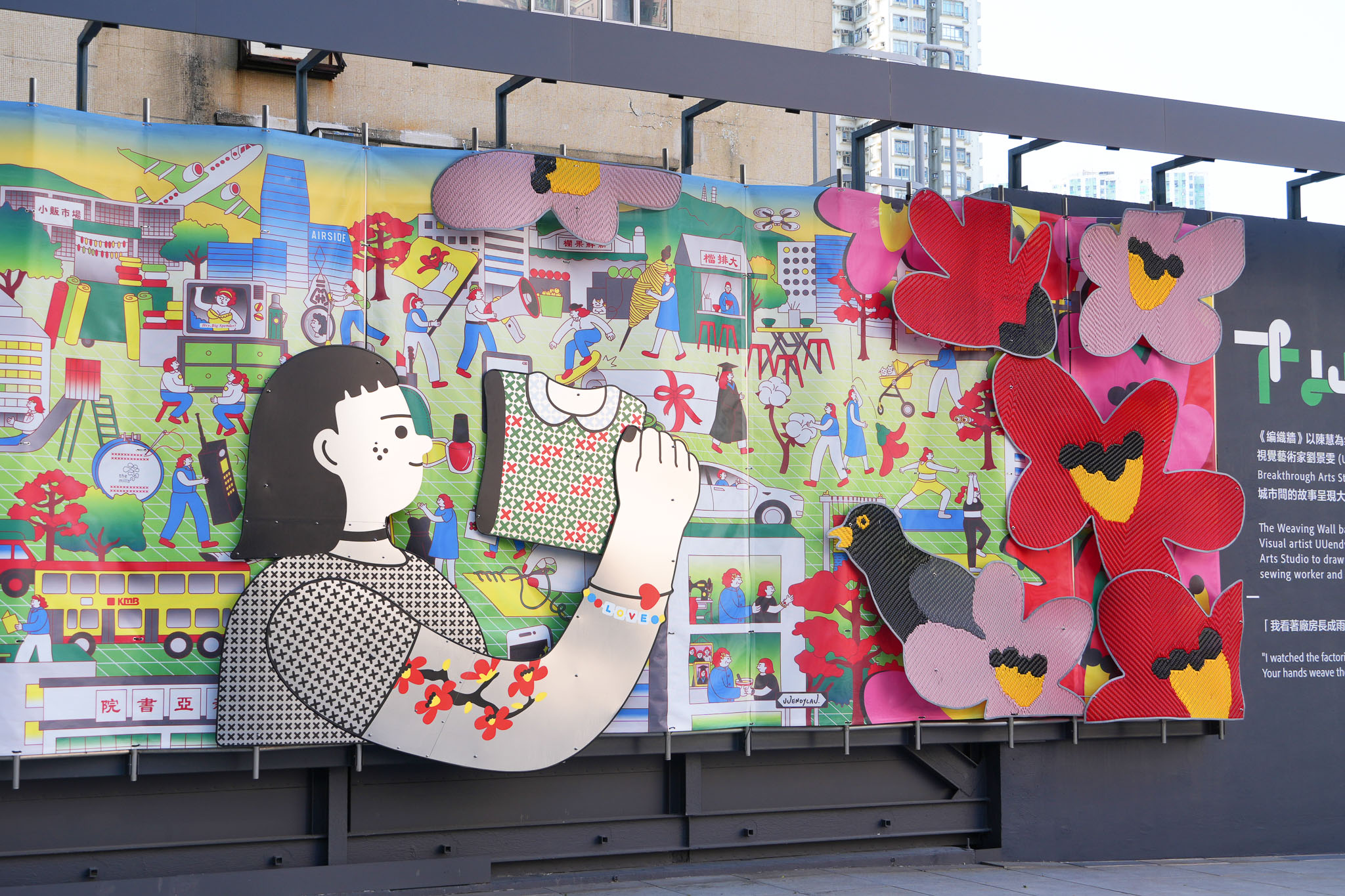


The Weaving Wall base on Chan Wai’s ‘Memory in Spring’ . Visual artist UUendy Lau and the weaving art team Breakthrough Arts Studio to draw and weave, presenting the story between sewing worker and the city she loves.
“I watched the factories sprouting like bamboo shoots after the rain. Your hands weave the prosperity and blooming of this city.”
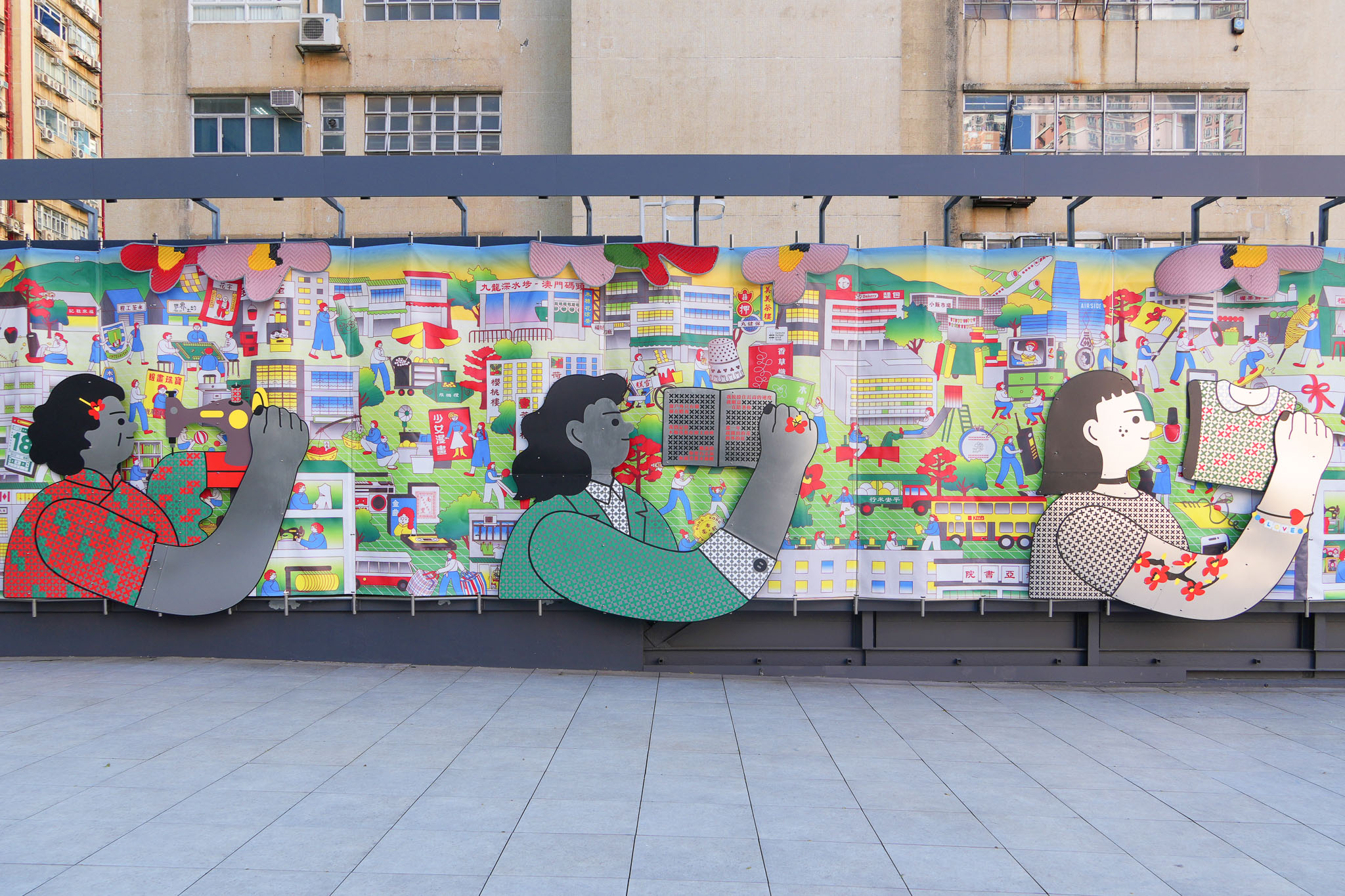


The Weaving Wall base on Chan Wai’s ‘Memory in Spring’ . Visual artist UUendy Lau and the weaving art team Breakthrough Arts Studio to draw and weave, presenting the story between sewing worker and the city she loves.
“I watched the factories sprouting like bamboo shoots after the rain. Your hands weave the prosperity and blooming of this city.”
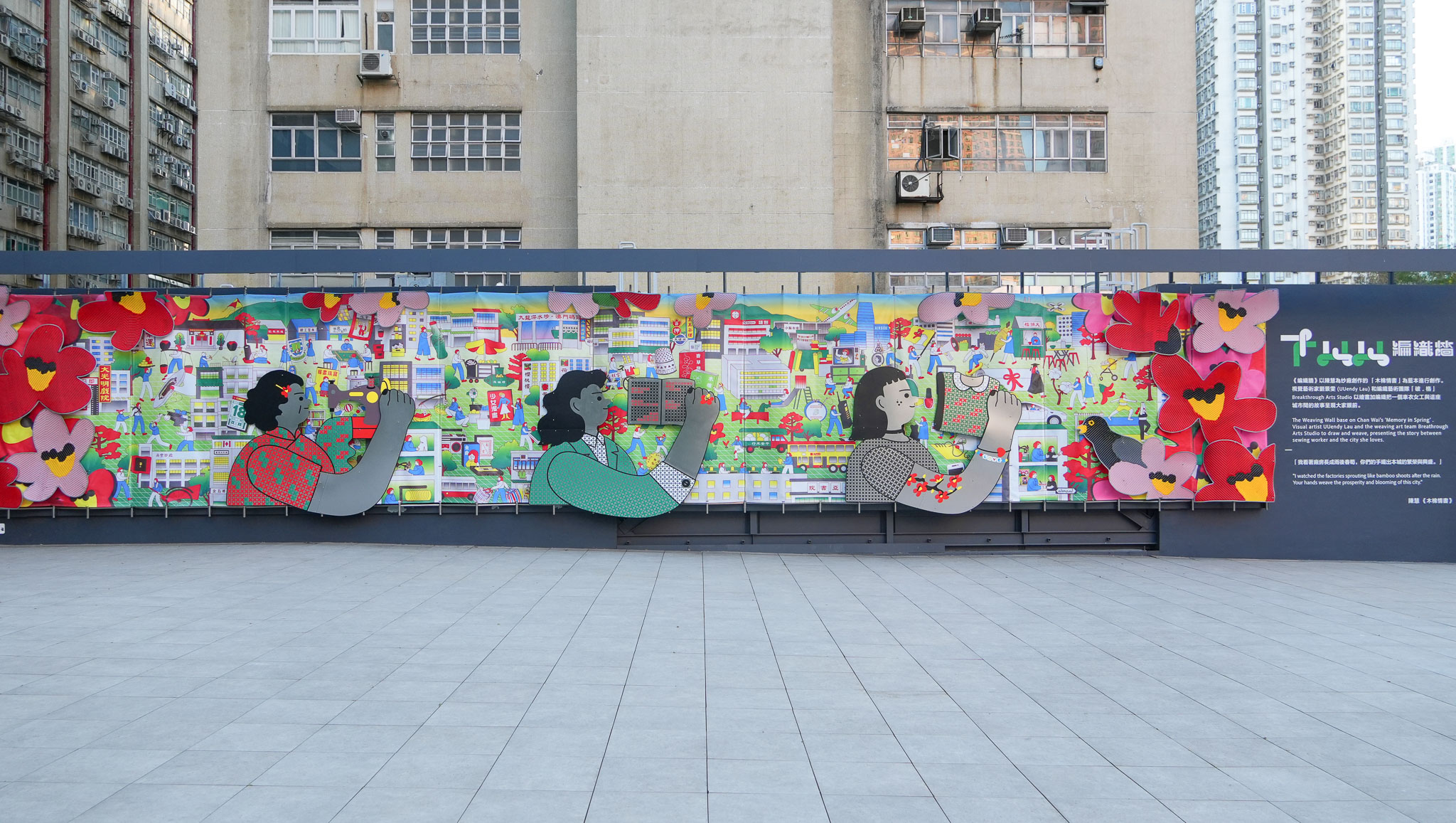


The Weaving Wall base on Chan Wai’s ‘Memory in Spring’ . Visual artist UUendy Lau and the weaving art team Breakthrough Arts Studio to draw and weave, presenting the story between sewing worker and the city she loves.
“I watched the factories sprouting like bamboo shoots after the rain. Your hands weave the prosperity and blooming of this city.”
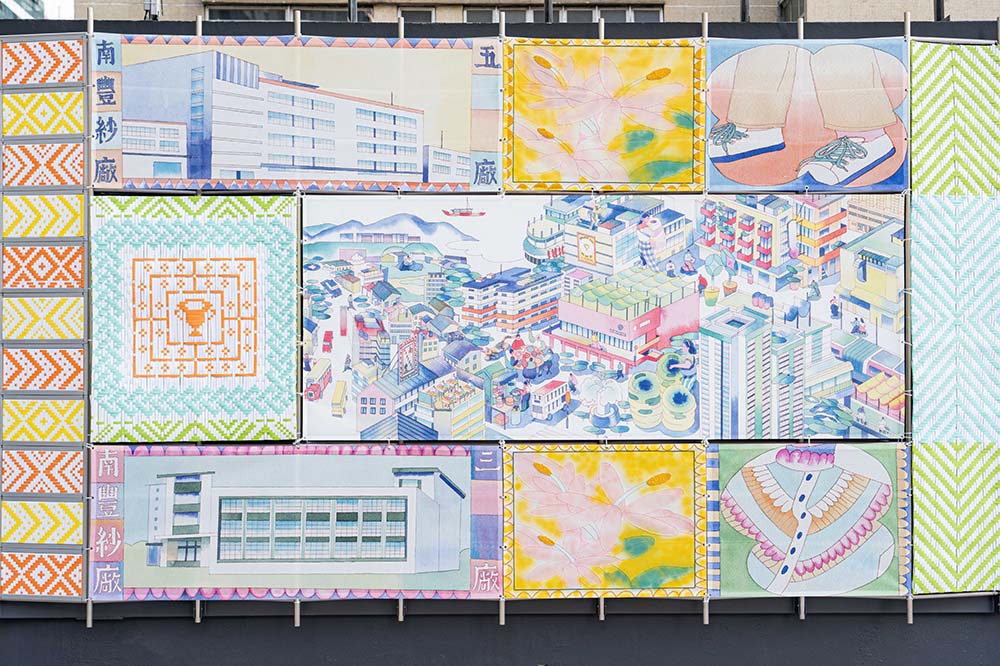


The Weaving Wall base on Chan Wai’s ‘Memory in Spring’ . Visual artist UUendy Lau and the weaving art team Breakthrough Arts Studio to draw and weave, presenting the story between sewing worker and the city she loves.
“I watched the factories sprouting like bamboo shoots after the rain. Your hands weave the prosperity and blooming of this city.”
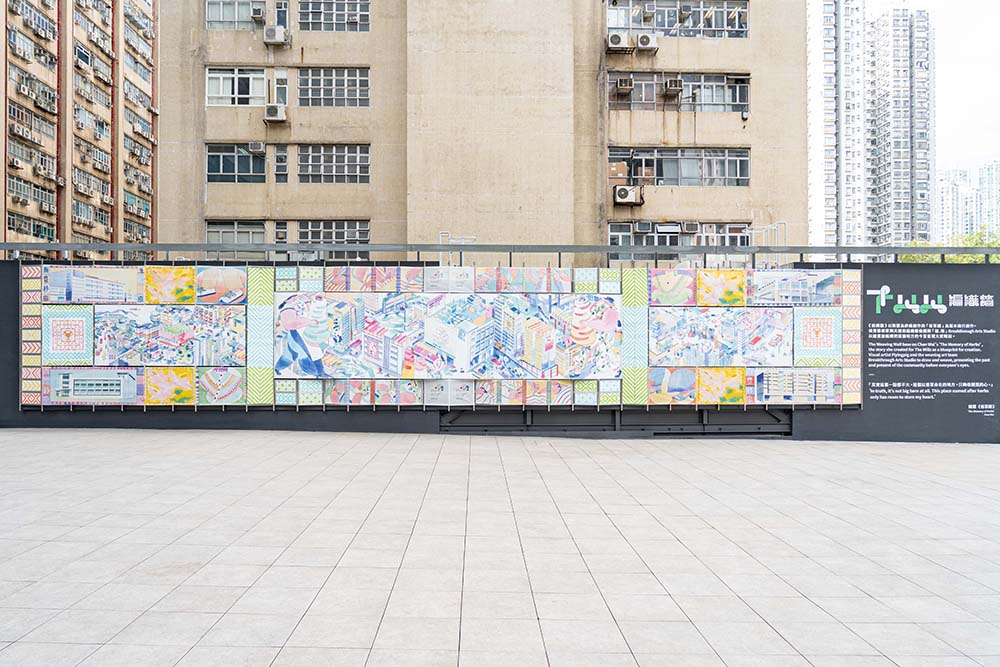


The Weaving Wall base on Chan Wai’s ‘Memory in Spring’ . Visual artist UUendy Lau and the weaving art team Breakthrough Arts Studio to draw and weave, presenting the story between sewing worker and the city she loves.
“I watched the factories sprouting like bamboo shoots after the rain. Your hands weave the prosperity and blooming of this city.”
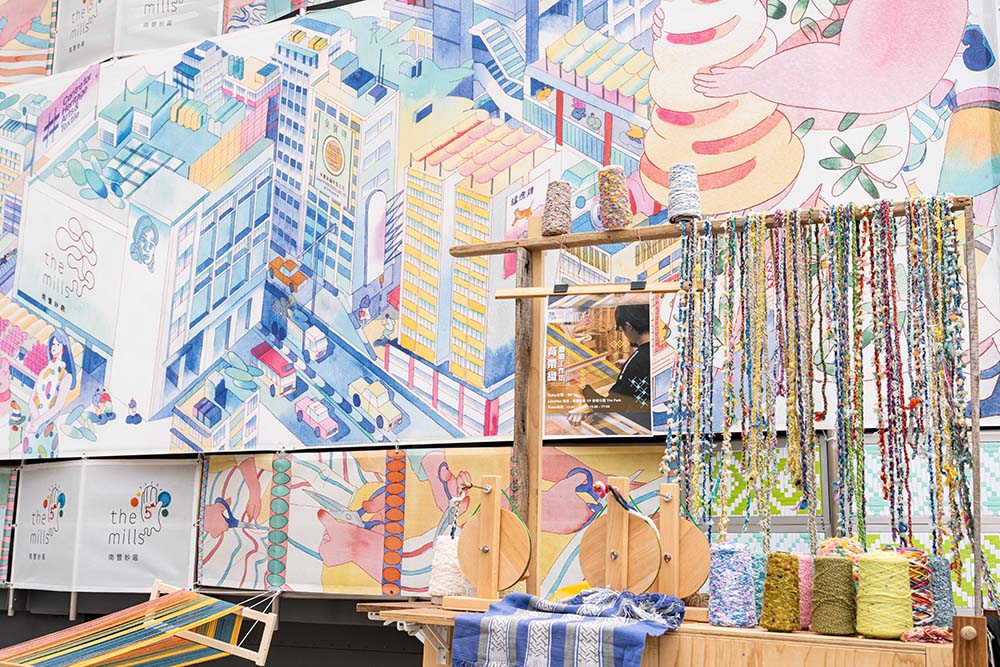


The Weaving Wall base on Chan Wai’s ‘Memory in Spring’ . Visual artist UUendy Lau and the weaving art team Breakthrough Arts Studio to draw and weave, presenting the story between sewing worker and the city she loves.
“I watched the factories sprouting like bamboo shoots after the rain. Your hands weave the prosperity and blooming of this city.”
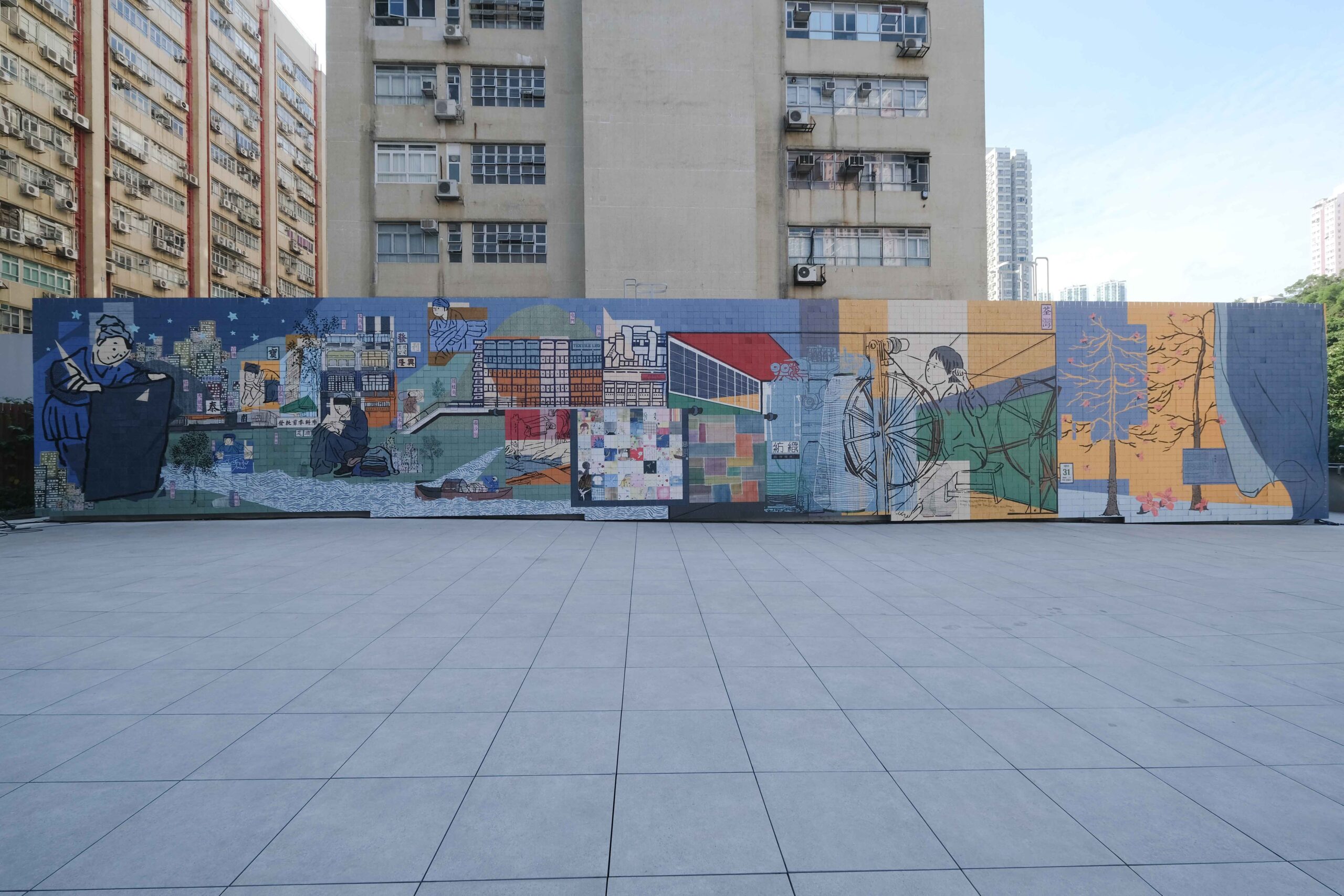


The Weaving Wall base on Chan Wai’s ‘Memory in Spring’ . Visual artist UUendy Lau and the weaving art team Breakthrough Arts Studio to draw and weave, presenting the story between sewing worker and the city she loves.
“I watched the factories sprouting like bamboo shoots after the rain. Your hands weave the prosperity and blooming of this city.”



The Weaving Wall base on Chan Wai’s ‘Memory in Spring’ . Visual artist UUendy Lau and the weaving art team Breakthrough Arts Studio to draw and weave, presenting the story between sewing worker and the city she loves.
“I watched the factories sprouting like bamboo shoots after the rain. Your hands weave the prosperity and blooming of this city.”



The Weaving Wall base on Chan Wai’s ‘Memory in Spring’ . Visual artist UUendy Lau and the weaving art team Breakthrough Arts Studio to draw and weave, presenting the story between sewing worker and the city she loves.
“I watched the factories sprouting like bamboo shoots after the rain. Your hands weave the prosperity and blooming of this city.”

